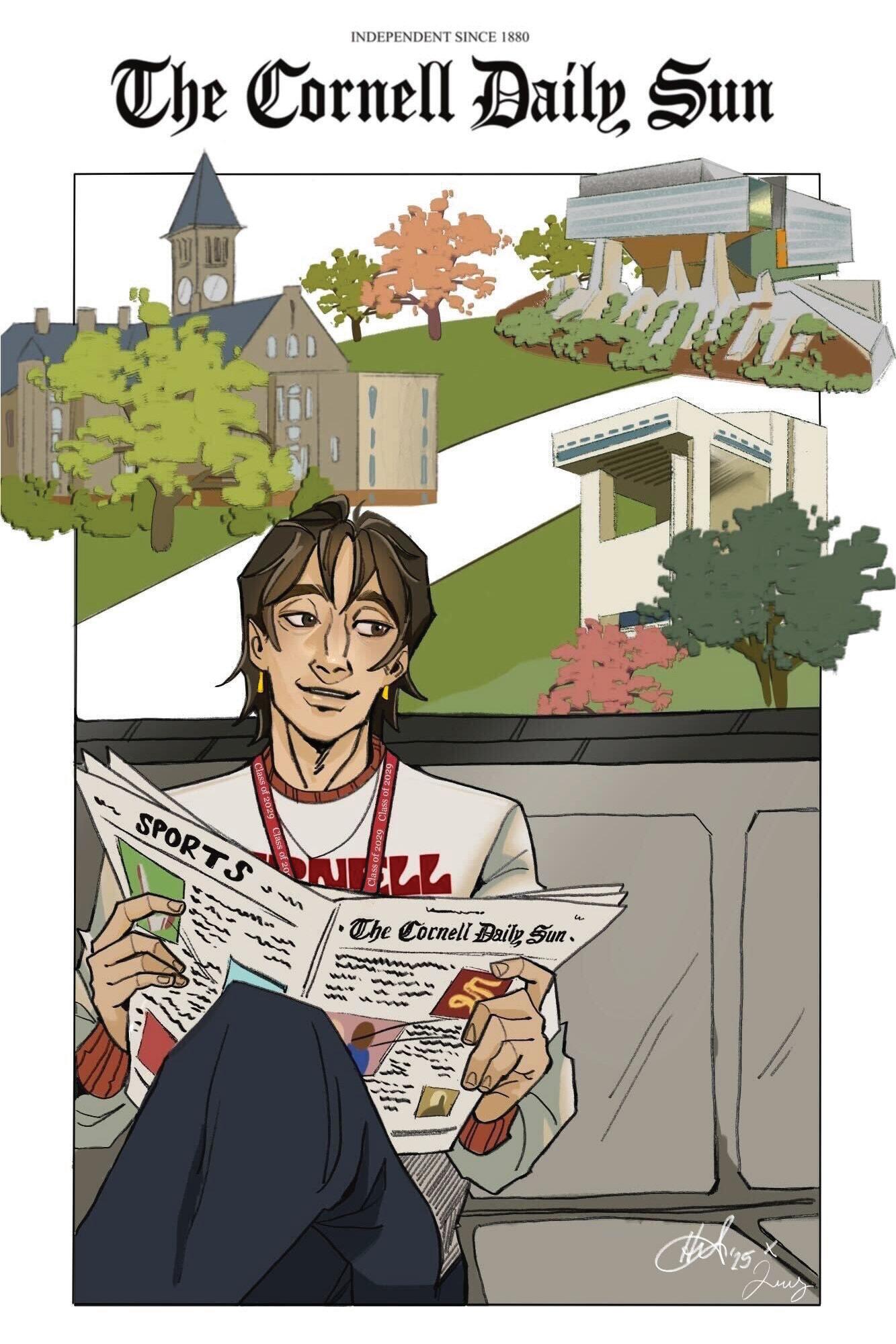

Table of Contents
Student Guide
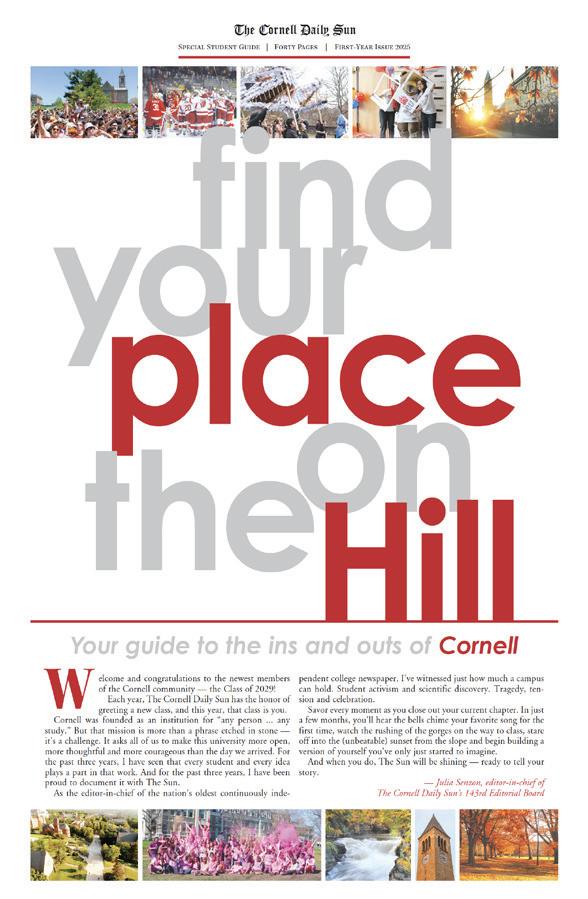
The Sun’s editors and reporters bring you a guide to life on the Hill. Inside you’ll find information on housing, student activities and orientation. You’ll also find a full-color campus map.
Arts and Culture
Because Nobody Can Study All the Time
So, you’re a smart kid. Congratulations. But not even you can spend all of your evenings in the library cramming for exams and dreaming of your future Ph.D. From local concerts to groundbreaking interviews with Hollywood icons, Arts and Culture is your ticket to college life the way it should be: Worry
free. The Sun is always front row center with the headliners and coverage of arts exhibitions in Ithaca.
This issue brings you some of the best arts stories of the semester, plus a spotlight of notable Cornell alumni writers, musicians and visual artists.
16-17

First-Year Issue Staf
Editor-In-Chief: Julia Senzon ’26
News: Cereese Qusba ’27 Varsha Bhargava ’27
Sports: Zeinab Faraj ’28
Main Cover Design: Hannia Arevalo ’27
Photo: Photos
and Nathan Ellison ’28
About the Cover:
Sports
For When Your Brain Needs a Rest
What is the Ivy League? Nothing more than an athletic conference. It’s just a coincidence that it is comprised of eight of the best colleges in the nation.
Cornell leads the way in what is widely known as the Ancient Eight, setting the bar for all of those lesser schools — like, um, what’s the name of that school near Boston? Yeah, nobody cares.
20-24
The cover features an array of iconic Cornell symbols, including McGraw Tower, the Herbert F. Johnson Museum and The Sun’s print newspaper — the best way to keep up with all things Cornell from sports to breaking news.
Read more about all Cornell sports has to offer on the flip side of this issue — the place where you can always find sports in The Sun.


A Night at The Sun
By SUN STAFF
Cornell has no journalism major — and we wouldn’t have it any other way. Here at The Sun, we subscribe to the philosophy that one learns best by doing. So it’s no surprise that at the nation’s oldest continuously independent college daily, we think of ourselves as the University’s journalism education. When you arrive on campus about a month from now, The Sun will also serve as your window to the world from our little corner of Ithaca.
Every day during the academic year, about 15,000 students, parents, alumni, administrators and local residents read the print edition of The Sun; another 15,000 people visit cornellsun.com daily. And in 2015, The Sun was ranked the number one college newspaper in the United States by The Princeton Review.
The Sun was founded in 1880. Since then, we’ve built up an impressive record of hard-hitting journalism and community service, and we have given generations of Cornellians something better to pay attention to in their 10:10 a.m. classes.
We’ve also delivered the skills it takes to succeed to a lengthy roster of Amer ica’s top writers and business people, jumpstarting the careers of Sun graduates E.B. White 1921, Kurt Vonnegut ’44, Dick Schaap ’55, Oscar Mayer ’34 and Frank Gannett 1898. More recently, The Sun has been home to Pulitzer Prize winners John Hassell ’91 of The Star-Ledger of Newark, Molly O’Toole ’09 and Keri Blakinger ’14 of The Los Angeles Times and Katie Engelhart ’09 of The New York Times. ESPN’s Jeremy Schaap ’91 was a Sun sports editor and NPR’s David Folkenflik ’91 was editor in chief. Former editor in chief Andrew Morse ’96 currently serves as president and publisher of The Atlanta JournalConstitution and former managing editor Jeff Stein ’13 founded The Ithaca Voice and is currently the White House economics reporter at The Washington Post. Former editor in chief Marc Lacey ’87 is now the managing editor of The New York Times.
dent-run newspaper is a multi-faceted organization that only works because of its members.
Editors spend what some might consider way too much time with one another, working on The Sun. But all agree on the irreplaceable role the paper has taken in their lives.
The News section — the paper’s largest — tracks and reports all campus life events and local and national issues relevant to you. Every day, the staff is talking to people around campus and conducting interviews in preparation for stories.
Where there’s news, The Sun is there covering it. From covering protest activity stemming from conflict in the Middle East and contentious Student Assembly elections, the News section has full access.
The Sports section works hard each day to keep Cornell abreast of the newest developments of the sporting world both inside and outside Big Red nation. With game recaps, athlete profiles and commentary on everything, you will always find action on the back page. And don’t forget to look for the seasonal pullouts for an in-depth look at Cornell’s athletics.

The Arts and Culture section is The Sun’s cool crew.
From movie reviews to exhibits at the Johnson Museum to local bands, Arts gives us the backstage pass to all the places to be and be seen.
Hidden behind the news you will find The Sun’s Opinion and Editorial section, a center of raucous campus debate where columnists and community members sound off about local and national issues alike.
The Science and Technology section plays a vital role at Cornell, one of the most profound research institutions in the world. Science reporters stay up to date with cutting-edge findings from Cornell scientists around the world.
The Sun’s Lifestyle department boldly provides advice, shares personal experiences and spotlights student life. The department includes dining, social, housing and SunSpots sections.

Watching the Clock
There is no regular day at The Sun, but here is what typically goes into producing a daily paper.
Morning:
Staffers read The Sun, go to class (maybe), work on that day’s stories. The business office is open from 9 a.m. to 5 p.m.
5 p.m.: Editors arrive at The Sun’s offices at 139 W. State Street, which is a 20-minute walk down the hill from
Central Campus or a five-minute drive or bus ride. They begin to lay out and edit the paper that will appear on newsstands the following day.
7 p.m. - 10 p.m.: Editors, designers and photographers meet to discuss articles and placement of stories in the next morning’s paper. Editors read and edit articles, working with the writers for accuracy and clarity. Editors assign future stories; other editors work on editorials and last-minute stories. Photographers
edit photos. Design staffers work on pages as stories are finalized.
10 p.m. - 12:30 a.m.: Breaking news stories come in; finishing touches are made to the paper’s content and design.
12:30 a.m.: The paper goes to bed. Stories, photos and other content are webbed for the online edition. The paper is printed in Towanda, Pennsylvania, and delivered to newsstands across campus.
If you want to become a part of this exciting tradition — and help write the next chapter of The Sun’s history — just show up. We’ll give you the skills you need for a career in news, sports and commentary.
Once you get to campus, you’ll see The Sun in dorms, dining halls and countless other locations — and every day online. But few realize what it actually means to “put out the paper.” Cornell’s only daily stu-
A picture is said to be worth a thousand words, which is why The Sun’s Photo department is so vital to The Sun. Our photographers go to great lengths to ensure that a story is visually represented, even if it means trekking in the rain and snow all over central New York.
What photos cannot capture is handled by the Graphics department, which creates a diverse range of visual elements used in nearly all of the print editions.
Creative and always inquisitive, our Layout and Design department knows style like the back of their hands. When they’re not laying out pages, our designers are helping to create seasonal sports supplements or covers for special issues, like the one you’re reading now. The Sun is much more than a printed paper, though. The Sun strives every day to provide our readers with fresh and engaging content on its website. The Multimedia department works with other departments to pro-
duce videos that supplement print coverage. The creativity that the department puts into filming and editing makes the story truly come to life.
The Social Media department works to keep our online audience constantly up with breaking news live updates, photo galleries and multimedia content on platforms including Instagram, TikTok, X and Facebook.
A New York State for-profit corporation run entirely by students, The Sun rises every morning thanks to the Business department. From selling advertisements
to managing a budget, the department keeps The Sun’s brand afloat and gives students the real-world experience of running a business. And in between the blood, sweat and tears that go into daily production, we find the time to have fun and keep you all — our community of readers — curious, connected and better informed.
SO, READY TO JOIN?
Look for recruitment details in The Sun during Orientation Week or email Julia Senzon ’26 at editorin-chief@cornellsun.com.
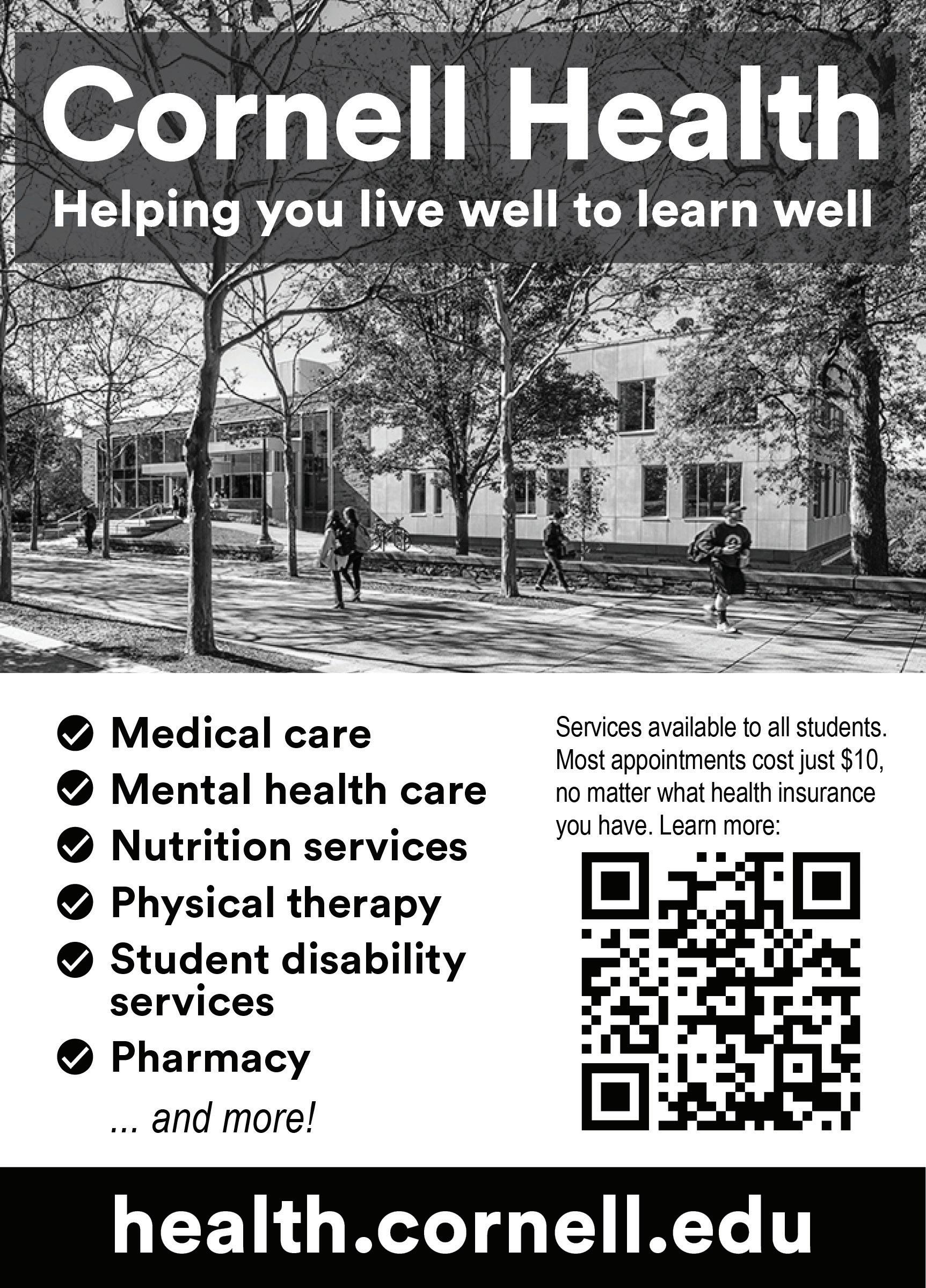
Middle Left: The Sun Building stands at the corner of W. State Street and N. Geneva Street in downtown Ithaca, one block west of the Ithaca Commons and on the same block as the State Theatre. Top Right: The top of the information box features an image of the elaborate woodwork of Alumni Hall on the second floor of the Sun Building.
Class of 2029 Admitted
5,824 new Cornellians; a 13.3 percent increase since 2024
By ANGELINA TANG Sun Assistant News Editor
This story was originally published on March 27.
Another year, another Ivy Day — student applicants around the world are celebrating their acceptance letters from Cornell.
At 7 p.m. on Thursday, regular decision results for the Class of 2029 were released to this year’s cohort of applicants. Early decision applicants already received their decisions in mid-December.
All of the Ivy League colleges release their regular decision results on the final Thursday in March, known as Ivy Day.
In total, 5,824 students were accepted to the next freshman class, which is a 13.3 percent increase from last year’s 5,139 accepted students. Accepted applicants come from all 50 states and represent a total of 115 countries — roughly twice as many as the number represented by the Class of 2028.
Accepted students are looking forward to their new life at Cornell. Maddie Moger ’29, an early decision accepted student from Queensbury,
New York, wrote to The Sun about her excitement to attend Cornell. “I feel honored and grateful to have been selected to attend such a prestigious university, but even more so, I feel beyond excited to start a new chapter of life at Cornell,” Moger said.
Moger is most enthusiastic about joining the “diverse community” on campus, where she can “meet new people who are completely different from [herself].”
Accepted students have until May 1 to accept their admission offers.
Cornell offers unique programs that fit the specific needs of incoming students. Jackson De Guzman ’29 is an incoming public policy major from Plymouth Meeting, Pennsylvania. He wrote to The Sun that he applied to Cornell because “the Brooks School is a cutting-edge policy program with strong connections to [Washington,] D.C.”
De Guzman also appreciated that since Cornell has so many colleges, the Brooks School is “a small school within a bigger university, so I get the perks of both small
and big schools.”
Others fell in love with Cornell through their high school programming. Michael Chen ’29 from Taiwan attended the Cornell International Debate Camp, a one-week summer camp, twice in 2023 and 2024, where he enjoyed participating in a “dynamic discussion atmosphere” with people from around the world, he said.
“That was my first realization of how diversity is very important,” Chen said. “In Taiwan, … everyone had the same beliefs.”
Others took a less conventional road to Cornell. Samara Cooper ’29 from Eugene, Oregon, was matched with Cornell through QuestBridge’s National College Match program.
QuestBridge is a non-profit organization that provides a community for and supports low-income students. Cooper received a full-ride scholarship to Cornell, room and board included.
To continue reading this story, please visit cornellsun. com.
Momodou Taal, Pro-Palestinian Voluntarily Leaves the Country
By BENJAMIN LEYNSE Sun News Editor
This article was originally published March 31.
Momodou Taal, a pro-Palestinian activist and international Ph.D. student, announced his decision to leave the country on Monday — ending a weeks-long struggle with the federal government that began when he sued the Trump adminstration.
Soon after Taal announced his decision on X and Instagram, his lawyers withdrew his lawsuit in federal court.
Taal first made national news when he, alongside Sriram Parasurama, a Ph.D. student in plant sciences, and Prof. Mukoma wa Ngugi , literatures in English, sued the Trump administration for allegedly violating their First and Fifth Amendment rights. Their suit claimed that the implementation of two Trump executive orders targeted pro-Palestinian speech and dampened dissent.
The U.S. State Department revoked Taal’s F-1 student visa after U.S. Immigration and Customs Enforcement identified him for “disruptive action” on March 14, one day before the lawsuit was filed. Taal would not be notified of the change to his visa status until March 21, according to testimony submitted in court by John Armstrong, senior bureau official for the U.S. Department of State’s Bureau of Consular Affairs.
Almost a week after Taal first sued the Trump Administration, his lawyers were sent an email requesting that he turn himself in to ICE on March 21.
Kotlikof Named Cornell’s President
By CEREESE QUSBA Sun News Editor
This story was originally published on March 21.
After serving eight months as interim president, Michael Kotlikoff has been named Cornell’s 15th president in a vote by the Cornell Board of Trustees on Friday.
This appointment is effective immediately, according to an email sent out to the Cornell community from Board of Trustees chair Kraig H. Kayser MBA ’84 and incoming chair Anne Meinig Smalling ’87.
Kotlikoff was named interim president on May 9, 2024, following former president Martha Pollack’s announcement of retirement. He was slated to serve two years as interim president, with a search committee intended to select the next president six to nine months prior to the end of Kotlikoff’s term.
In June 2024, Kotlikoff announced a search committee for the selection of his replacement as provost that included “a very broad swath of folks to participate, from across colleges, constituencies and academic disciplines, as well as undergraduate and graduate student representation.” The committee invited the Cornell community to provide their input on the selection through an online survey as well as a confidential mailbox.
However, there was no public announcement of the selection process for president — which took place significantly earlier than scheduled — nor was an official committee or community input system named.
When asked why Cornell decided to end its two-year search for a permanent president or whether external candidates were considered, Cornell Media Relations referred The Sun to the Friday email announc-
ing Kotlikoff’s election and the Cornell Chronicle article. However, neither directly addressed the two questions.
When asked about his plans for the time after his interim presidency in a September interview with The Sun, Kotlikoff said that he would “almost certainly retire,” after completing his two-year interim presidency term.
“I closed my lab a few years ago. I still teach a little bit, but I’ll retire at that point,” he said at the time.
When asked why he was serving a twoyear term as interim president, Kotlikoff said, “The two-year term is to give stability. I was provost, and if I now become president on an interim basis or on an acting basis, and we immediately start searching for a president we would have to start searching for a president and a provost at the same time.”
Kotlikoff suggested that the next president will “most likely be an external candidate and one who’s not as familiar with Cornell.”
During his 25 years at Cornell, Kotlikoff has worked as a lab director, professor, teacher and mentor, researcher, department chair and dean.
As interim president, Kotlikoff established a firm stance on expressive activity.
“While this right [freedom of expression] is foundational, it is not unlimited,” Kotlikoff wrote in an August University statement. “The expressive activities of individuals necessarily unfold within the context of our broader university community, and as such they are bounded by the need to protect the core functions of the university and the reciprocal rights of others.”
Going into the position of interim president, Kotlifkoff and Provost Kavita Bala established in February a new task force to prevent sexual assault on campus.
To continue reading this story, please visit cornellsun.com.
Trump Admin Freezes More Tan $1 Billion of Cornell Funds
Taals lawyers unsuccessfully tried to challenge this request in court, submitting a motion for a temporary restraining order that would prohibit the government from deporting Taal in accordance with the executive orders that Taal’s lawsuit was challenging. This motion was denied by Judge Elizabeth Coombe of the Northern District of New York on Thursday.
According to the post made to his social media, Taal decided to leave because he stopped believing that the courts would guarantee his personal safety.
“Given what we have seen across the United States, I have lost faith that a favourable ruling from the courts would guarantee my personal safety and ability to express my beliefs,” Taal said. “I have lost faith [that] I could walk the streets without being abducted. Weighing up these options, I took the decision to leave on my own terms.”
Shortly after Coombe denied Taal’s motion, his lawyers filed a new amended complaint and temporary restraining order. However, following Taal’s announcement, his lawyers withdrew the lawsuit altogether, according to a notice of voluntary dismissal submitted to the court.
In a post to X, Taal’s lead counsel, Eric Lee, wrote, “I feel like a stranger in my country. What is America if people like Momodou are not welcome here?”
Reflecting on his choice to leave, Taal wrote on X and Instagram that, “This is of course not the outcome I had wanted going into this, but we are facing a government that has no respect for the judiciary or for the rule of the law.”
By MATHEW KIVIAT Sun Assistant Managing Editor
This article was originally published April 8.
The federal government has frozen over $1 billion in funding for Cornell, according to members of the Trump administration. This comes amid Title VI investigations of Cornell by the U.S. Department of Education.
The move follows the slashing of more than $3.3 billion in federal funding from several Ivy League universities, including Columbia, Harvard, the University of Pennsylvania, Brown and Princeton. The Trump administration also froze $790 million in funding for Northwestern, according to The New York Times.
Cornell receives both federal and state funding for its research and grants for students. The freezing of Cornell and Northwestern’s funding from the federal government will primarily involve grants and contracts with the departments of agriculture, defense, education and health and human services, The New York Times reported.
A Monday evening statement from Cornell administrators explained that the University was “aware of media reports suggesting that more than $1 billion in federal grants have been frozen” but had “not received information that would confirm this figure.”
However, Cornell saw more
than 75 stop work orders from the Department of Defense on Monday related to Cornell research “that is profoundly significant to American national defense, cybersecurity, and health,” according to the statement. The ED Office for Civil Rights sent a letter on Feb. 14 to Cornell and other federally funded educational institutions, ordering the dissolution of “racial preferences” and other University race-conscious decisions. The ED highlighted in the letter that universities could potentially lose federal funding if they did not comply within 14 days.
Following the initial letter, the OCR announced the opening of an investigation of Cornell and 44 other universities under Title VI. The OCR explained that the investigations came amid allegations that the universities violated Title VI of the Civil Rights Act of 1964 by working with The Ph.D. Project — which “purports to provide doctoral students with insights into obtaining a Ph.D. and networking opportunities, but limits eligibility based on the race of participants,” according to the OCR.
Cornell was also one of 60 schools sent letters from the ED on March 10, warning the universities to “fulfill their obligations under Title VI of the Civil Rights Act to protect Jewish students on campus” or see “enforcement actions.”
To continue reading this article, please visit www.cornellsun.com.
KEHLANI SLOPE DAY SERIES

Kotlikoff Criticizes Kehlani’s Slope Day
Headline: ‘It’s Too Late To Secure Another Performer’
After the April 10 announcement that Kehlani was selected to headline Slope Day, President Michael Kotlikoff responded to mounting concerns at the Thursday Student Assembly meeting by stating, “It’s too late to secure another performer.”
The soulful R&B singer is set to perform on Slope Day, the annual campus-sponsored concert on Libe Slope after the last day of classes. In the week following the announcement, dissatisfaction has surfaced as students and parents have learned of the artists’ active political, specifically pro-Palestine, presence on social media.
‘I Am Not Antisemitic’: Kehlani Speaks Out After University Rescinds Invitation to Headline Slope Day
Cornell revoked Kehlani’s invitation to headline Slope Day over what President Michael Kotlikoff labeled “antisemitic, anti-Israel sentiments.” A few days after the April 23 announcement, the R&B singer rebuked Kotlikoff’s classification.
“I am not antisemitic, nor anti-Jew,” Kehlani said in a video posted to her Instagram on Saturday. “I am anti-genocide. I am anti the actions of the Israeli government, I am anti the extermination of an entire people, I am anti the bombing of innocent children, men, women — that’s what I’m anti.”


Gunna to Replace Kehlani as Slope Day Headliner Following Rescinded Invitation
The Slope Day Programming Board announced Gunna as the headliner for Slope Day on Friday morning, nine days after President Michael Kotlikoff rescinded Kehlani’s invitation on April 23.
Slope Day, the annual concert held on Libe Slope at the end of the academic year, is financed by the Student Activity Funding Commission — a body responsible for allocating a portion of the undergraduate student activity fee, which all students pay to the University.
Gunna, the four-time Grammy nominated hip hop artist with songs like “Lemonade,” “f*kumean” and “Drip Too Hard,” will be headlining the performance.
Cornellians for Israel Petitions Against Slope Day Headliner Kehlani Cornellians for Israel launched a petition against the selection of Kehlani as this year’s Slope Day headliner, stating that the use of “her platform to publicly call for the ‘intifada’ and to ‘dismantle Israel’” makes Jewish students feel unsafe. The petition, which has reached over 5,200 signatures in four days, calls on the University to create “an alternative experience.”
Kehlani was announced as the Slope Day headliner on April 10 and since then has faced backlash. Addressing the Student Assembly on Thursday, President Michael Kotlikoff criticized Kehlani’s Slope Day headline but said that it was “too late to secure another performer.”
The petition expressed Jewish students’ anger and safety concerns about attending Slope Day


Kotlikoff Rescinds Kehlani Invite, Citing Antisemitism and ‘Hateful Views’
After revealing to a group of about 70 concerned students at a town-hall style meeting on Tuesday afternoon that a decision regarding Slope Day would be made “within 24 hours,” President Michael Kotlikoff announced that Kehlani’s invitation to perform was rescinded in an email to the student body on Wednesday morning.
In the email, Kotlikoff wrote that it was not the intention for Kehlani’s slope day performance to have “injected division and discord into Slope Day.” “For that reason, I am rescinding Kehlani’s invitation and expect a new lineup for a great 2025 Slope Day to be announced shortly,” Kotlikoff wrote.
Celebrating the End of the Semester
On Wednesday, May 7, Cornell students, staff and alumni celebrated Slope Day, the annual concert celebrating the end of spring semester classes. The event, organized by the Slope Day Programming Board, was headlined by DJ group Louis the Child and rapper Gunna. Battle of the Bands winner Lucky Strike kicked off the concert, followed by sets from student DJs Two (Asian) Friends and FREQ.

Kotlikof’s ‘Conversation With Students’ Activists Hold ‘Community Slope Day’
This article was originally published May 7.
Cornellians will be able to choose between not one but two Slope Days — the official University music festival and the grassroots Community Slope Day, organized by local activists in response to the University rescinding Kehlani’s headliner invitation.
The Community Slope Day music festival will take place from 11 a.m. to 4 p.m. on Wednesday, entirely overlapping with Cornell’s Slope Day. It will take place at Stone Bend Farm in Newfield, New York, an approximately 20-minute drive away from campus.
Following the April 10 announcement of Kehlani as the original Slope Day headliner, some students and parents criticized the artist’s anti-Israel rhetoric and social media presence. Cornellians for Israel also launched a petition against the selection of Kehlani as the Slope Day headliner that accumulated over 5,000 signatures.
Cornell revoked Kehlani’s invitation to headline Slope Day over what President Michael Kotlikoff labeled “antisemitic, anti-Israel sentiments.”
But the cancellation sparked criticism from student groups about freedom of speech and institutional neutrality. The Community Slope Day Instagram account urged students to “boycott Slope Day,” writing that Kehlani’s “opposition to the genocide in Palestine isn’t hateful” and that the decision was made “without representative input of the student body.”
Community Slope Day organizer Elliot Walsh ’24
M.S. ’24 said that leaders of the event expect a turnout of approximately 500 people.
The festival is free and open to all Ithacans,
and free Lyft rides will be provided, organizers said. The University’s Slope Day limits admission to Cornellians, offering free admission to Cornell undergraduates, while faculty, staff, graduate students and alumni can buy tickets for $55 to $75.
“Community Slope Day is grounded in a much more expansive vision of what community is,” Walsh said. “It’s not just the Cornell community. … We see the residents of Ithaca and of surrounding towns, we see Ithaca College students as being community members on equal footing, and we want to take this opportunity to open up the event to whoever will come.”
Through Community Slope Day, Walsh said he hoped to create a space for all members of the Ithaca community to celebrate the end of the school year without participating in Cornell’s festival, which he saw as “repressive.”
He added that the community event aims to reclaim “grassroots student control” over the festival, which has previously been celebrated without approval or sanctioning from the University over its 125-year history.
“People want a party and people deserve a party, but not if that party is organized by fascists, not if it comes at the cost of suppressing Palestinian speech and not if it comes at the expense of trampling on student autonomy,” he said.
Community Slope Day will feature local, underground and independent artists like the punk rock band Secret Service Men, the country-western group Cast Iron Cowboys, the rapper Overpade and Ithaca College rock band Lost Mary’s.
To continue reading this article, please visit www. cornellsun.com.
This article was originally published May 14.
The day before President Michael Kotlikoff rescinded Slope Day headliner Kehlani’s invite to perform, top administrators promoted an event to several pro-Israel and historically Jewish Greek Life organizations to meet with concerned students. At the meeting, administrators discussed potential options for the concert, protocols for political activity at Slope Day and student reactions to the controversial headliner.
R&B singer Kehlani was set to perform at Slope Day, the annual campus-sponsored concert on Libe Slope following the last day of classes. On Wednesday morning, Kotlikoff announced that he rescinded the artist’s invite in an email to the campus community. When Kehlani was first named as headliner, dissatisfaction surfaced as students and parents discovered the artist’s social media presence, with one Cornellians for Israel post citing her “anti-Israel rhetoric.”
At the meeting — described in the advertising of the event as a “conversation with students” — Provost Kavita Bala revealed that “[Kotlikoff] will make the decision over the next 24 hours.” This contrasted Kotlikoff’s statement that it was “too late to secure another perform-
er that will be acceptable or appropriate for Slope Day” at a Thursday Student Assembly meeting in response to concerns raised by students and parents regarding her anti-Israel rhetoric and social media presence.
At Thursday’s Student Assembly meeting, Kotlikoff explained that a contract was made with Kehlani that made it clear that if there were any “political events at the performance,” all compensation would be forfeited.
Throughout the meeting, students asked about the University’s intended plans regarding the concert. Kotlikoff noted that the “practical issue” with selecting another artist is the lack of time until Slope Day, which is set to take place on May 7.
“We would need to get the best, most popular artist and most representative artist that we can get and secure them. Basically, everybody is booked, you know, already,” Kotlikoff said. “So I would love to go through a very inclusive process, etc. The reality is … if we do this, we would get the best performer we could get.”
Kotlikoff explained that while the administration was considering removing Kehlani from the lineup, they were not primarily considering cancelling Slope Day.
To continue reading this article, please visit www. cornellsun.com.
APRIL 29
APRIL 23
2
MAY 14
APRIL 25
By MAX TROIANO Sun Staff Writer
NATHAN ELLISON / SUN STAFF PHOTOGRAPHER
NATHAN ELLISON / SUN STAFF PHOTOGRAPHER
COURTESY OF WIKIMEDIA COMMONS
COURTESY OF WIKIMEDIA COMMONS
COURTESY OF WIKIMEDIA COMMONS
HANNAH ROSENBERG / SUN FILE PHOTO
By SOPHIA KOMAN and DOROTHY FRANCEMILLER Sun Staff Writer and Sun Managing Editor

A Look Inside Cornell’s Test-Optional Policies
After four years of test-optional and test-blind policies, Cornell is set to reinstate the standardized testing requirement for the Class of 2030
By JOANNE HU
This story was originally published on April 29, 2024.
On April 22, 2024, Cornell announced its reinstatement of standardized testing requirements for Fall 2026 first-year applicants despite continuing the current suspension of the policy for the Fall 2025 admissions cycle.
The reinstatement follows similar moves from peer institutions including Harvard, Yale, Dartmouth and Brown, which all will require Fall 2025 applicants to submit standardized test scores.
The Fall 2026 admissions cycle will be the first for Cornell to require test scores since the requirement was originally suspended in April 2020 due to the COVID-19 pandemic. The University stated in 2021 that it had entered a two-year “deliberate experimental review” to guide admissions on future standardized testing policies.
In Spring 2023, a task force led by the school administrators, professors and faculty members explored the impact of removing the testing requirements on the Class of 2025 and 2026. Reported by Cornell’s Office of Institutional Research and Planning, a summary of the key findings complemented the latest reinstatement, which argues that students admitted with reported test scores show better academic performance than students admitted without scores.
To further explore the impact of the testing requirement suspension, The Sun sourced admission data from the Common Data Set and several colleges’ admissions offices to identify trends for students admitted to and enrolled in the University and other Ivy League colleges.
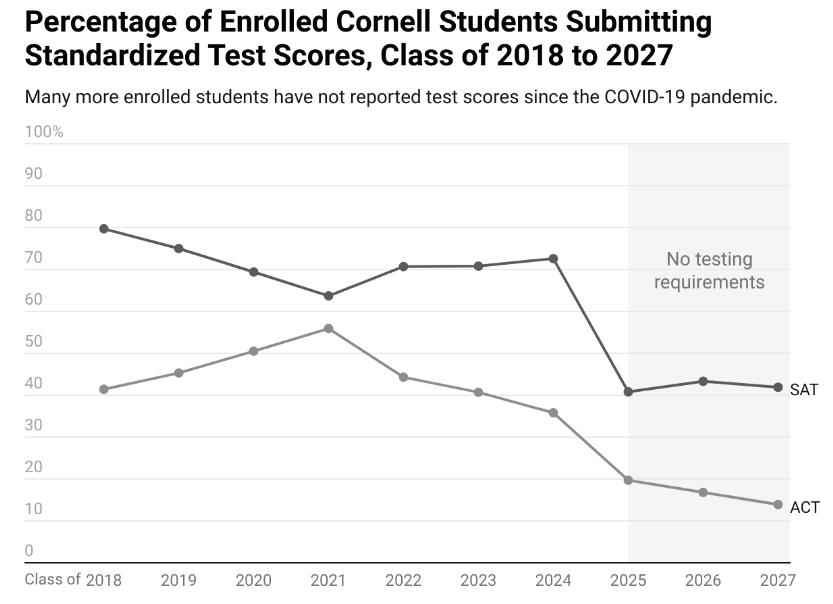
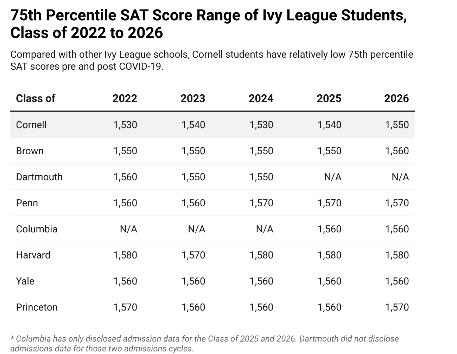
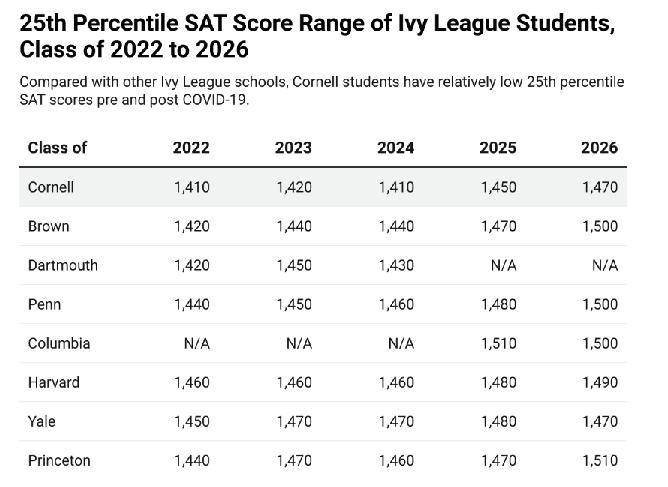
Without testing requirements, the proportion of enrolled students submitting SAT or ACT scores respectively dropped by more than one-third. While around 70 percent of enrolled students at Cornell submitted SAT scores in the years preceding the COVID-19 pandemic, the percentage dropped to 41 percent for the Class of 2025 and then remained at a similar level of 43 percent for the Class of 2026 and 42 percent for the Class of 2027. Similarly, ACT submissions greatly declined during the test-optional period, decreasing from about 40 percent to less than 20 percent after the Fall 2021 admissions cycle. This declining trend in submitted scores is consistent among all Ivy League colleges. However, Cornell has seen the largest decline in the proportion of enrolled students with SAT submissions. It had the highest percentage of enrolled students submitting SAT before the COVID-19 pandemic but the lowest thereafter. Brown and the University of Pennsylvania are two other Ivy League universities with large submission declines.
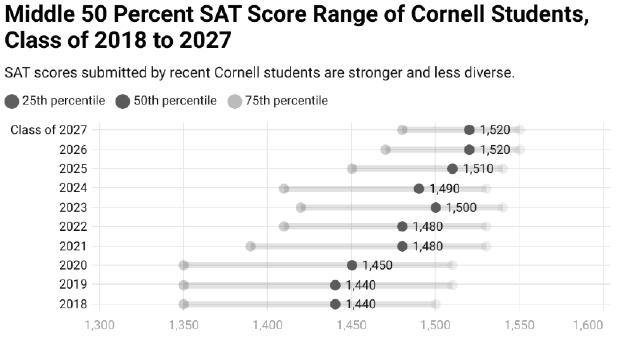
dents enrolling at Cornell after the requirement suspension submitted scores that are higher but less diverse. This trend echoes the Office of Institutional Research and Planning’s report that claims recent students who did not submit their SAT scores tended to have lower scores than those who submitted. Self-reported SAT scores from the New Student Survey for the Class of 2026 show that more than 60 percent of SAT scores submitted for the class’s admission were above 1500.
When comparing across Ivy League universities, the trend of stronger and less diverse reported SAT scores exists for all Ivy League schools. No matter if compared before or after removing the testing requirement, enrolled Cornell students have relatively lower 25 and 75 percentile scores compared with other schools.
The impact of submitting test scores on acceptance is far from negligible. While fewer than 30 percent of Cornell applicants submitted SAT or ACT scores, more than 40 percent of students accepted by Cornell and about half of enrolled students submitted their scores from the Classes of 2025 to 2027. However, this difference is not as significant in test-blind colleges — including the College of Agriculture and Life Sciences; the College of Architecture, Art and Planning and the S.C. Johnson College of Business.
As explained in the Office of Institutional Research and Planning report, this difference may be attributed to the fact that applicants with stronger standardized scores are more likely to have strong application profiles overall and are thus more likely to be admitted.
The data above does not reveal many nuanced factors relevant to the suspension’s impact. According to the Office of Institutional Research and Planning’s report, The 2022 New Student Survey revealed that students’ decisions to submit standardized test scores were shaped by socio-economic factors including the type of high school, family income and access to and use of application guidance counselors.
Among students who scored above 1400 on the SAT, only 62 percent of Black students submitted their scores compared to 74 percent for White students and 79 percent for Asian students.
While the proportion of Cornellians who reported scores declined, those who did sub-
mit SAT scores in their application during the test-optional period have stronger scores overall. The middle 50 percent range of submitted SAT scores to Cornell slid from 1410-1530 for the Class of 2024 to 14801550 for the Class of 2027. The range shrunk from 120 to 70, with the 25th percentile increasing by 70 points.
These range changes indicate that stu-
According to an April 22 University announcement, Cornell’s reinstatement of test requirements is based on evidence that students from underrepresented socioeconomic backgrounds may choose to withhold scores that are below Cornell’s average overall but would advantage them in Cornell’s admissions process once contextualized. The decision to reintroduce test requirements thus intends to increase diversity in the student body.
Former Sun Assistant News Editor
JOANNE HU / FORMER SUN ASSISTANT NEWS EDITOR
JOANNE HU / FORMER
JOANNE HU / FORMER
The Corne¬ Daily Sun
Independent Since 1880
143rd Editorial Board
JULIA SENZON ’26
Bridgewater, N.J.
Editor in Chief
ERIC HAN ’26
New York, N.Y.
Associate Editor
SOPHIA DASSER ’28
New York, N.Y. Opinion Editor
ILANA LIVSHITS ’27
New York, N.Y.
Assistant Opinion Editor
AUDREY IM ’26
Queens, N.Y. Business Manager
SOPHIA TORRES ’26
Redwood City, Calif. Marketing Manager
SYDNEY LEVINTON ’27
Dix Hills, N.Y.
Arts & Culture Editor
JAMES PALM ’27
New York, N.Y.
Assistant Arts & Culture Editor
JENNA LEDLEY ’27
Penn Valley, Pa.
Assistant Arts & Culture Editor
MELISSA MOON ’28
Los Angeles, Calif.
Assistant Arts & Culture Editor
SOPHIA ROMANOV IMBER ’28
Miami, Fla.
Assistant Arts & Culture Editor
KAITLYN BELL ’28
Long Island, N.Y. Lifestyle Editor
MAIA MEHRING ’27
Great Neck, N.Y. Lifestyle Editor
KARLIE MCGANN ’27
Syracuse, N.Y.
Photography Editor
MATHEW KORNICZKY ’28
San Diego, Calif.
Assistant Photography Editor
STEPHAN MENASCHE ’28
Queens, N.Y
Assistant Photography Editor
MIRELLA BERKOWITZ ’27
New York, N.Y.
Multimedia Editor
HANNIA AREVALO ’27
McAllen, Texas Graphics Editor
JADE DUBUCHE ’27
Bronx, N.Y.
Social Media Editor
HUNTER PETMECKY ’28
Los Angeles, Calif. Layout Editor
RENA GEULA ’28
DOROTHY FRANCE-MLLER ’27
Glens Falls, N.Y.
Managing Editor
MATTHEW KIVIAT ’27
Clarksburg, Md.
Assistant Managing Editor
VERA SUN ’27
Scarsdale, N.Y.
Advertising Manager
ALEX LIEW ’27
Queens, N.Y. Human Resouces Manager
BENJAMIN LEYNSE ’27
Leonia, N.J. News Editor
VARSHA BHARGAVA ’27
Basking Ridge, N.J. News Editor
ISABELLA HANSON ’27
Chadds Ford, Pa. News Editor
CEREESE QUSBA ’27
New York, N.Y. News Editor
REEM NASRALLAH ’28
Queens, N.Y.
Assistant News Editor
ANGELINA TANG ’28
Bufalo, N.Y. Assistant News Editor
KATE TURK ’27
Gulf Breeze, Fla.
Assistant News Editor
JEREMIAH JUNG ’28
Chino Hills, Calif. Assistant News Editor
KAITLIN CHUNG ’26
Corning, N.Y. Science Editor
MARISSA GAUT ’27
San Diego, Calif. Science Editor
GABRIEL MUÑOZ ’26
Miami, Fla. City Editor
JANE HAVILAND ’28
Barnegat, N.J. Features Editor
ALEXIS ROGERS ’28
Evanston, Ill. Sports Editor
ZEINAB FARAJ ’28
Jacksonville, Fla.
Assistant Sports Editor
DYLAN GRAFF ’28
Los Angeles, Calif.
Assistant Sports Editor
SIMRAN LABORE ’27
Great Neck, N.Y Layout Editor ALLISON HECHT ’26
Larchmont, N.Y. Newsletter Editor
Saint Louis, M.O. Weather Editor
From the Editor
A New Dawn, Same Pursuit of Truth
Te Sun gathered at its downtown Ithaca ofce on Saturday to elect the 143rd Editorial Board. Dedicated and daring Sunnies stepped forward into their new roles, promising to protect the truth, above all else.w
Te truth can be hard to fnd these days. We have entered a world where leaders in the highest levels of government treat truth as malleable, and journalism as an industry that can be bent, rather than a pillar of democracy.
Papers across the nation have been hit with lawsuits and directives by the Trump administration. Te Associated Press was barred from covering news events at the Oval Ofce for declining to call the Gulf of Mexico the Gulf of America. And in justifying the move, White House Press Secretary Karoline Leavitt stated, “It’s a privilege to cover the White House.”
If we at Te Sun stand by one promise, it is that we will always remain courageous. When Te Los Angeles Times and Te Washington Post shelved endorsements for Kamala Harris last fall, Te Sun went full steam ahead on our own.
With police and administrators around, Te Sun stayed steadfast in its on-the-ground protest reporting — part of a collective student newspaper efort that Te Pulitzer Prizes honored during the web of encampment demonstrations last spring.
College papers preserve the narrative. We are documenters of history, and in an age of censorship and erasure, historians are needed more than ever.
Our readers have a key part to play in building our record. Contact us with tips to ensure the stories that matter are being covered. Send us correction requests when we mess up. And join the conversation by submitting letters to the editor and guest columns.
As Te Sun dawns for another year, we will light the path to a more transparent future. We have never backed down from bringing the truth to our readers, and we won’t start now.
Cornell Isn’t Ready for You
Welcome to Cornell, Class of 2029! As you pack your bags, trudge through online orientation and pick your classes, I hope you’re all taking a moment to reflect on the incredible, astonishing work that got you here. It hasn’t been the same path for everyone: some of you have known you wanted to go to Cornell since you were five; others threw in an application on a whim. Some got in early decision; others just found out that they got off the waitlist. In high school, some of you spent every waking moment studying; others in the gym; and others still doing service work out in the world. Now, all those diverse experiences — the vast and varying perspectives and stories — are being consolidated into one community: Cornell.
Over the next few months, you’re going to have the chance to find your people here. You’ll discover, in getting to college, that there exists kinship you never thought possible. Your most niche interests, your favorite books and movies, esoteric quirks and hyperfixations … here, they will grow into communities. Don’t be afraid of what makes you different; you might just find people who are different in the same way — and you might just leave people a little more different than they were before.
For those who enter with a sense of creeping dread, an anxiety that this won’t be all you wanted and more, I urge you to leave those doubts at the door. For those who arrive and hit a wall, struggle in their classes or fail to find their found family, I urge you to keep on searching. I promise, as a rising senior once filled with those exact same doubts and fears, that by the time you’re done, each and every one of you will be able to look back with a sense of wonder and accomplishment at the person you have become.
Don’t let Cornell change you, but don’t let it leave you the same. In arriving to Ithaca, you agree both to challenge the status quo and to be challenged by your classmates and professors. You agree not to grow complacent in your accomplishments or chauvinistic in your place here. The University is a hulking beast of an institution — miles and miles of century-old buildings atop a hill flanked by moat-like gorges — but that does not mean you must succumb to its will. Rather, it is you who will push Cornell into a brighter future: Learn of the students who occupied Willard Straight Hall in 1969, the Arts Quad throughout the 1980s, Day Hall in 1993 and all around campus the last few years. Cornell is only as great as its students … and its students are only as great as their willingness to oppose injustice and fight for their convictions. So all in all, get excited. Cornell isn’t ready for you, but we can’t wait to see what you bring. It’ll be an awe-inspiring four years, a lifetime of memories and a transformation of school and self that we can’t even begin to imagine. Have fun! Oh, and join The Sun!
— Max Fattal, associate editor
Sun's View
What An Editorial Is and Isn’t
It’s vitally important that the Cornell campus understands the deliberative process that goes into writing Sun editorials. So here’s what you should know about what a Sun editorial is — and isn’t.
The Sun is a newspaper that embraces different perspectives on the issues that matter. Editorials that appear in The Sun don’t necessarily represent the personal viewpoints of every member of The Sun.
Editorials serve as a testament to our paper’s long-standing values. They are a way for the Editorial Board of The Sun to take a stand when history calls for it. They are a voice for what The Sun as an institution believes in. The Editorial Board, which consists of the editor in chief, associate editor and opinion editor, work closely together to produce editorials that are bold and well-researched.
It should never be assumed that the opinions outlined in any given editorial speak for every member of The Sun individually. Editorials also are entirely independent of The Sun’s news coverage, meaning that the views they express have no influence on the facts of objective news stories or the process that goes into writing and reporting on them.
Personally harassing members of a student-run newspaper over the content of an editorial is immature and unacceptable, especially when those members were not involved in the creation of that editorial. Only the editor in chief, associate editor and opinion editor write editorials at The Sun.
The Cornell Daily Sun has been a fiercely independent, community-driven organization for 143 years, and editorials are one important way The Sun has remained that force for positive change all along.
— The Editorial Board
SUBMIT A LETTER TO THE EDITOR OR GUEST COLUMN
The Cornell Daily Sun is devoted to publishing a broad and diverse set of content from the Cornell and greater Ithaca community.
Guidelines on how to submit can be found at Cornellsun.com. And here is our email: opinion@ cornellsun.com
The
Don’t Let School Get in the Way of Your Education

Eric Joseph Reilly
Eric Reilly is a graduating senior from the College of Arts and Sciences. He served as the Assistant Managing Editor on Te Sun’s 142md Masthead and News Editor on the 141st Masthead. He can be reached at ereilly@cornellsun.com.
My dad’s dad, John Joseph Reilly, used to say that. A strange quote from an educator — he was a high school social studies teacher in Bridgewater, Massachusetts.
Grandpa Reilly died before I was born, when my dad was only a freshman at Davidson College. All I know of Grandpa Reilly I know from my dad — that he kept a piece of the Berlin Wall on his desk, that he had his students paint a world map on their classroom wall, that he would have been at every one of my basketball games.
For much of my life, Grandpa Reilly’s anti-academy tagline rarely resonated with me. Elementary, middle, high school — I kept my head down, got my grades and did little else. I was content. I loved school. Then I came to Cornell.
Maybe it was the freedom, the lack of rules. Maybe it was the repetitive Environment and Sustainability classes that my University of Vermont transfer credits somehow didn’t satisfy. Or maybe it was the loose attendance policies (which I carefully studied to calculate the fewest number of classes I would have to attend to earn an A; a strategy which more often resulted in a B). Whatever it was, I no longer found adequate joy in attending class.
Joining The Sun as a news writer and working my way up to assistant managing editor had its own set of sacrifices. Staying late nights at 139 W State St. and being on call 24/7 meant sleeping through morning classes, quitting my job as a research assistant and devoting less time to relationships. But everything I lost, I gained in education.
For example, on Halloween night 2023, when I should have been out on the town, I was on the phone with my dad. A suspect had been charged for
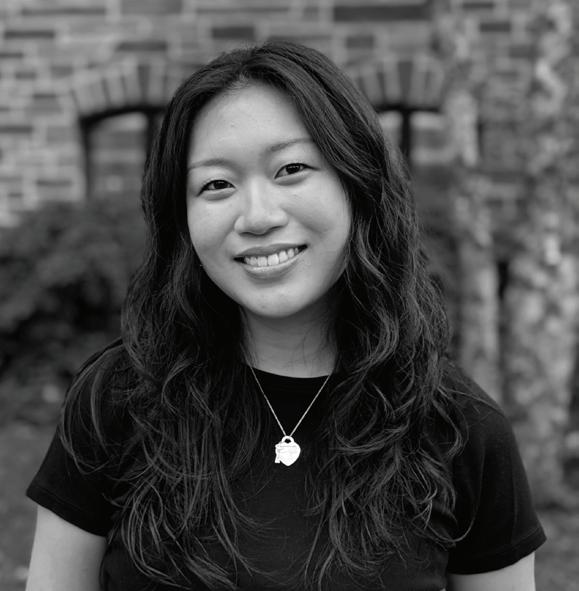
Serin Koh
posting antisemitic threats, and he was scheduled to appear in court the next morning. I wanted to go, but I would lose attendance points on a lecture and discussion section. My dad’s advice was familiar, no, familial — “don’t let school get in the way of your education.” 10 hours later, I crammed into a car with four fellow Sunnies, and I was on my way to Syracuse.
That morning, as my classmates watched slides on a screen, my classroom was a courtroom. Sitting beside 20 professional reporters, I heard a mother hold back tears as her mentally ill son stepped handcuffed beside his public defender. And I watched as Patrick Dai, through shaky and scared breath, admitted to authoring the violent, vile posts as his prosecutor read them aloud.
But school is not everything. If it were, I would never know how many more stars you can see through a pair of binoculars, how to hang a hammock where not even sadness can find you.
No law course can tell you what it’s really like in a courtroom. No semester in psychology can predict how a mother feels when she sees her son in an orange jumpsuit. No journalism course can teach you how to beat CNN on a story. Don’t let school get in the way of your education.
These lessons soon became continuous. Covering the encampment protests forced me to balance my journalistic principles with my care for our community, interviewing President Kotlikoff taught me how to ask tough questions of authority, and reporting on a meeting between top administrators and parents showed me how Cornell’s “content-neutral” policies can be differentially communicated. These moments were more valuable than any university class.
I do not mean that school is unimportant, that academia is useless. How else can I justify to myself the hundreds of thousands of dollars that I dropped on a Cornell diploma? Hell, I still dream of earning a Ph.D., of taking after Grandpa Reilly and becoming a teacher. School must matter.
But school is not everything. If it were, I would never know how many more stars you can see through a pair of binoculars, how to hang a hammock where not even sadness can find you. How silent Beebe Lake sleeps. These are Life’s lessons.
My message is this — don’t ditch every class, but when academics inhibit extracurricular education, make the tradeoff. Those moments mean more than any lecture or letter grade. Don’t let school get in the way of your education.
Confessions of a Senior
Tere are many days when I have sat and pondered how my college experience might have been diferent had I followed the more traditional path: Would I have stayed in touch with freshmen friends? How would I have adjusted to Cornell if I had spent my frst year here? What would my workload be like if I pursued a diferent career path? What memories would I have made if I had not taken a gap semester? Am I missing out on the ultimate college experience, and am I not making the most out of my years as a Cornellian?
Serin Koh is a graduating senior from the College of Arts and Sciences. Her fortnightly column And Tat’s the Skoop exploredstudent, academic and social culture at Cornell. She was a dedicated Graphics Contributor and Columnist.She can be reached at skoh@cornellsun.com.
Wegrin and regret. It’s the feeling that in approximately 25 days, the day will fnally come when the Class of 2025, clad in scarlet stoles, will cross the stage and leave not as fellow Cornellians, but as fellow alumni. As the bittersweet anticipation of freedom and the simultaneous impending doom of true adulthood march towards me, I can’t help but wonder the question that churns in all seniors’ heads: What did Cornell teach me?
My years as a student have strayed from what many may call the “conventional” college experience; I transferred into Cornell Arts and Sciences as a sophomore, took a gap semester in 2023 spring, and just earlier this semester, decided I wanted to graduate early this summer instead of completing all eight semesters of university. As a Literatures in English major who is also embarking on the pre-medical track, my past two years have been spent juggling between chemical equations and Shakespeare quotes — a rather precarious performance.
In a school of approximately 16,000 undergraduates plopped amidst isolated mountains in upstate New York –– which is always concerningly cloudy and cold for six months of the year –– it is easy to fall victim to this epidemic of second-guessing, anxiety and loneliness. Troughout high school, we are promised a glorious, hopeful urban legend: College will be the best four years of our lives. Yet when you receive your frst, second and third 64 on an organic chemistry exam, lose friends, doom scroll alone in your bed on a Friday night, miss your 9 a.m. class with required attendance, sufer from a mysterious cold for a week, trudge through a full day after sleeping three hours or fnd yourself counting spare dollars by the end of the semester, you may feel the piercing betrayal of a broken promise — and perhaps even more devastatingly — of failure.
Such is the reality of college: It is actually not the peak of your life, nor should it be. Te expectation that these four years will secure the rest of your future or unlock untapped interests are mere advertisements for applying students and overwhelming burdens upon current undergraduates. Tat is not to say, of course, that such things are impossible, but the guise of a college diploma as a savior and a solution to all worldly and philosophical dilemmas weaves a toxic blanket of competition, self-hatred, disappointment and, ultimately, a fear of failure.
I wouldn’t say I’ve found a home here on top of the hill. Don’t get me wrong — I’ve rolled in laughter with friends in the library, slipped out at midnight for froyo from Jason’s, belted godforsaken songs at karaoke, discovered some of my favor-
ite books from my English classes, napped on the sun-dripping Slope, indulged in CTB cheesecakes and conversed happily with professors — just to name a handful of irreplaceable memories from my time at Cornell. However, I fnd Cornell to be something far from a comfortable home: It is instead a place of both turmoil and peace, anger and laughter, community and solitude, failure and success. While it houses some of my favorite stories and experiences, it also holds some of my worst moments of isolation, self-doubt and mental burnout.
Such is the reality of
college:
It is actually not the peak of your life, nor should it be.
Yes, it is true that once we exit the gates of Cornell, the rest of the seniors and I will have to face much more dire challenges: merciless bills, grueling jobs, post-graduate parents and existential crises here and there. Yet I believe that our four years have prepared us for these moments; we are no longer 18-year olds waiting for the “peak” of our lives to come to us, but are burgeoning adults — armed with our own defnitions of identity and independence — who can now claim and sculpt our own “primes.”
So if someone were to ask me, “What did you learn from Cornell?” I would respond that it had taught me what exclusion, loneliness and failure are, and therefore, how I am an agent of my own experiences. I would say that I am glad that my four years here were not the best years of my life because they have prepared me for all that is to come. And so, I end my column with this: If Cornell has not fulflled all of your fantastical daydreams, do not let expectations dictate the future — in this case, I truly do believe that the grass is greener on the other side.
Goodnight (Daily) Sun, Goodnight Moon
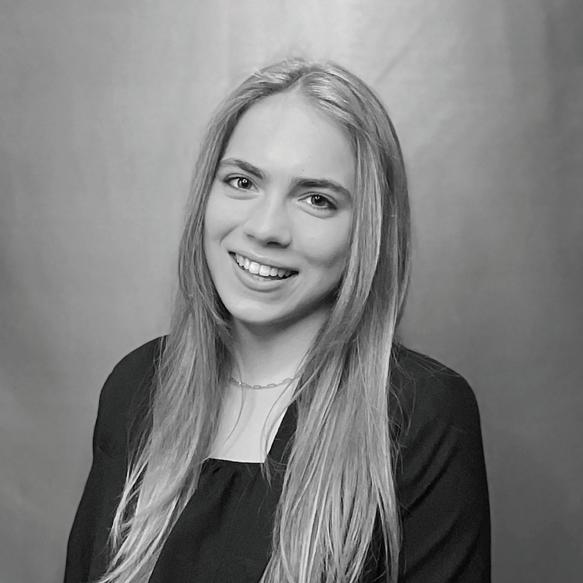
Carlin Reyen
Carlin Reyen is a graduating senior in the College of Arts and Sciences. Her fortnightly column Just Carlin’ It Like It Is centers around student life, social issues, Cornell life hacks and the University’s interactions with the broader community. She was an Assistant News Editor on the 141st Masthead. Carlin can be reached at creyen@cornellsun.com.
When I talk to people about being a college student, they often ask, “Do you love Cornell?”
I feel that this is a reductive question; Cornell has not been a monolith of an experience for me. There are so many moments where I have felt incredible joy, and yet — as readers of my column may note — many moments I have felt discouraged by campus culture, institutional bureaucracy and world affairs.
My first few semesters here were a time of trial and transition: I distinctly remember my first day of college in 2021, standing in a Barton Hall bustling with my new classmates, feeling insignificant — and slightly terrified — with the fact that I knew not a single person amidst the crowd.
Though not easy at first, finding community here has been integral to my experience. The best part of my senior year has been walking amongst the stunning buildings on campus (and some not so stunning — Uris Hall comes to mind) on the way to class,
being able to greet familiar faces of fellow Cornellians who I have worked with on a project, met through a mutual friend or gotten to know through a club, for example. It is euphoric to walk a campus with the built confidence of having made these connections, seeing all the people I have come to know as friends over the past four years, whose diverse passions I have come to understand and appreciate, and whose future trajectories I can only imagine. Often, I think of that first moment in Barton as a comparator and ruminate on how lucky I am to have connected with so many during such a short period.
Growing up in the Southern Tier of New York, just an hour south of Ithaca, I was initially ambivalent about attending college so close to home. However, I grew to appreciate the close proximity to my family and unique experiences my background brought to my time at Cornell. It has been both humbling and enriching to learn from the varying experiences of classmates from various parts of the U.S. and internationally and to see how these lived experiences inform each student’s approach to learning. Through taking a variety of discussion-based courses in different disciplines, these stories have become a part of my lens for viewing subject material and have challenged me to look beyond my own understanding of the world.
I met many unique individuals through the Cornell Daily Sun itself. Beginning my tenure with the newspaper as a news staffer allowed me the unique opportunity to interview many a Cornell professor, student, staff member or community member in Ithaca. I joke that I love journalism because I am inherently nosy, but I have found over the last four years that journalism is a powerful outlet for learning about the perspectives of others and sharing this newfound knowledge with the general public.
That being said, one of the things I will miss most about Cornell is the privilege of
Iaccess to information. I have not taken for granted the close proximity to field experts that this education has presented me: the ability to access current research in academic journals through the Cornell Library System and the wealth of knowledge available in databases and newspapers alike. In our age of digital misinformation, I recognize how valuable peer-reviewed, evidence-based research is, and how hard to come by it can be.
During my time at Cornell, I have tried to immerse myself as much as possible in the community, to spend my semesters attending talks by faculty and visiting scholars and to learn as much as possible, both inside and outside of the classroom. I spent last summer here working for the Ithaca Times, which allowed me to explore the surrounding city further and interact with more members of the greater Ithaca community than ever before.
I would highly recommend every Cornell student spend at least one summer in Ithaca. During the semester, it is easy to get caught up in the stress of school and the internship search, to lose sight of the natural beauty of Ithaca and the rich history of the University. Too often, it seems that undergrads spend most of their time here in a “Cornell bubble” on the Hill, and whether this is due to time constraints or resistance to engaging with the broader Ithaca community, this fact makes me sad. During “summer in Ithaca,” as my friends and I affectionately call those calm, humid months, I learned to slow down and appreciate the present moment and haven of opportunity that Cornell can be.
Cornell can be incredibly difficult; I certainly have had my fair share of highs and lows. Though I look back with intense nostalgia from my vantage point as a graduating senior, there were plenty of nights spent panicking about assignments, moments where I beat myself up over an awkward conversation with a peer and agonizing thoughts about where I stood intellectually. In these
moments, I found space for myself by continuing to put myself out there, to seek out communities and spaces where I felt seen by my peers, felt a sense of belonging.
These spaces may be different for everyone, but as a result of my interactions with many kind and genuine people amidst the chaos of Cornell, I truly believe they are out there. To anyone struggling to feel a sense of belonging, I would encourage readers to try something that may seem impossible or to engage with a new group of people and just see what happens.
“Fake it ’til you make it” is a tired mantra, but it has helped me meet some amazing people in times of self-doubt. After all, these four years are a time to form new experiences and test interests; trial and error is okay. Cornell is a perfect venue for this.
A few weeks ago, for example, I saw an advertisement for an actress for a student film. I had never acted in anything in my entire life, and maybe I was propelled solely by the imminence of my graduation, but I asked myself, “If not now, when?” The experience ended up being incredibly fun, and the student crew and other actors were so kind and encouraging. The opportunity to still meet new people and have positive interactions weeks before graduation filled me with hope about the Cornell experience, and by proxy, about finding my place in the world beyond college.
I leave with significant gratitude for the opportunities Cornell has granted me, coupled with the weight of responsibility to better the world around me. Although I have gone through some of the most difficult moments of my life here, I also can trace much personal, social and academic growth that has carried me through the semesters here. For this, I suppose I do love Cornell, flaws, idiosyncrasies and all.
Cheers to Everyone We Will Ever Meet
n just 10 days, 6,000 robed Cornellians — myself included — will make a long-anticipated walk from the Arts Quad to Schoellkopf Field to bid a ceremonious goodbye to the last four years of class and chaos on the Hill. Right now, I’m sitting at a wooden table in Goldwin Smith 232, a room I’ve had class in nearly every semester at Cornell, and, until a few minutes ago, I was scrolling TikTok, procrastinating both studying for my last fnal (HADM 4300, Wines) and writing this article.
Luckily, I built my TikTok For You Page brick by brick and my algorithm knew exactly what I needed to see: A PBS photo deck full of advice for graduating seniors via quotes from their stars, backed by Lorde’s ever-nostalgic Ribs. A few scrolls into the post was a quote from Bill Nye, who I am partial to because of our shared alma mater and because he reminds me of 6th-grade science class, which I loved.
“The last four years have simply been a preview for the rest of my life.”
Te quote was this: “Everyone you will ever meet knows something you don’t.” Tank you, TikTok, PBS and Bill Nye; now I can start writing. Like my classmates, I arrived in Ithaca in the fall of 2021, excited, scared, of the tail end of the pandemic, feeling like I simultaneously knew everything and nothing. I was fresh out of the pond-sized echo chamber that is small-town Indiana, nervous to see if I would sink or swim in the ocean that is Cornell.
I’m not sure how or when it happened, but at
some point I realized that the best way to swim was to become a sponge: to absorb as much knowledge, wisdom and experience as possible, to understand that everyone around me has something unique to ofer and to embrace the opportunity to fnd out what that is. For me, this radical curiosity is what defnes the Cornell experience.
Today, when friends and professors ask me if I’m “ready to graduate,” the little voice in my head screams, “absolutely not!” Everyone around me seems ready, but I’m feeling scared and emotional; certainly not “ready.”
In some strange way, reading that Bill Nye quote under the light of a classroom that has cradled me from my frst ever class all the way through procrastinating in preparation for my last undergraduate exam made it click: I actually am ready to graduate, because the Cornell experience I’m mourning isn’t ending.
Like many, what I have loved most about college is feeling like I can learn from everyone and everything around me, but I mistook that feeling as something only possible in Ithaca. Tat phenomenon won’t end when we leave Cornell, it will expand. As a now well-practiced sponge, I will be free to absorb knowledge, wisdom and experiences from the whole world, not just the world on our slope. Te last four years have simply been a preview for the rest of my life and, if you’re committed to being a lifelong learner, they’ve been a preview for yours, too.
It’s okay for us to feel sad about graduating from frat parties, Slope Days, club meetings and formals, but remember, we’re also graduating from prelims, DuoMobile, homework and pre-enrollment. What we aren’t graduating from is the Cornell experience: an understanding that “everyone you will ever meet knows something you don’t,” and the innate Cornellian desire to forever pursue that knowledge.
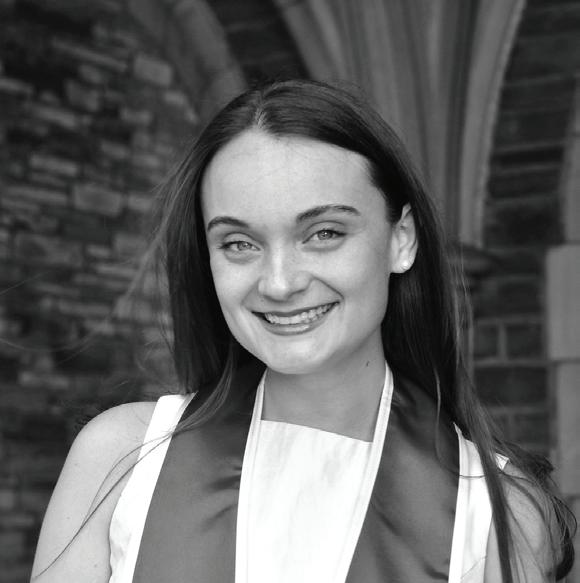
Grace Elmore
Grace Elmore is a graduating student studying English in the College of Arts & Sciences. She is a senior columnist and her column ran during alternate Sex on Tursdays this semester and can all be found on Instagram and Substack. Comments can be sent to gelmore@cornellsun.com.
Turns out, there was a nine-word sentence capable of both summarizing the type of person Cornell has taught me to be and shifting my feelings about graduation from scared and emotional to scared and excited. Ironically, those are the exact feelings I had moving into Cornell four years ago… Tat chapter was amazing, so I’m confdent the next will be the same.
Despite my days-away English degree, I couldn’t form a sentence that powerful, but Bill Nye was able to (see, I learned something from someone else). For that, and for my fond memories of 6th-grade science, I owe him a thank you.
Some housekeeping: (1) Every student feeling melancholy about graduating and/or leaving Ithaca should listen to the song Ithaca by Beatenberg. It might make you feel sadder, but it is beautiful, and I always fnd myself coming back to it. (2) Stay tuned for a Let’s Talk About Sex swan song; this won’t be the last you hear from me.







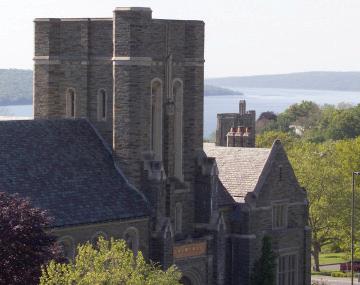
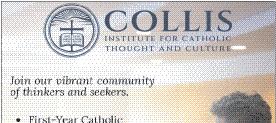
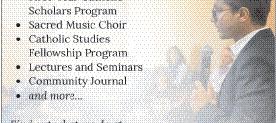
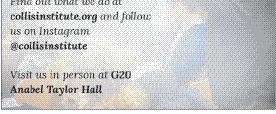


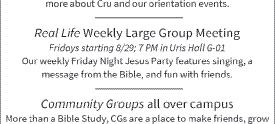








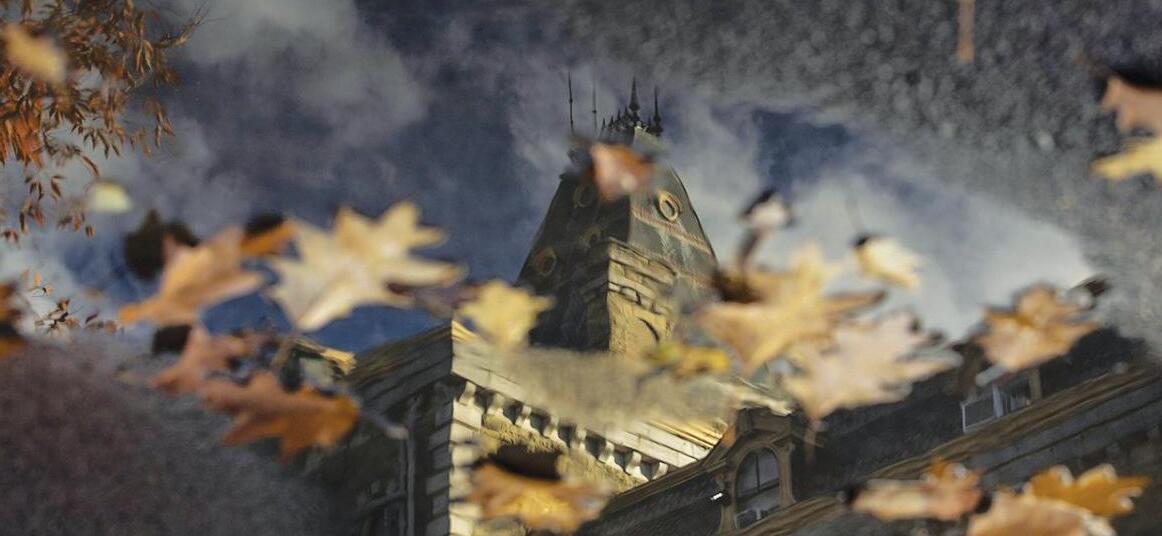















ARTS & CULTURE
Artistic Alumni to Know
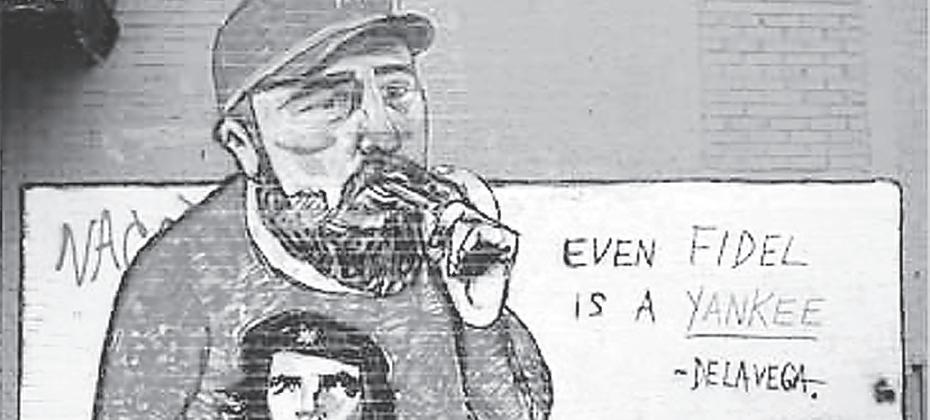
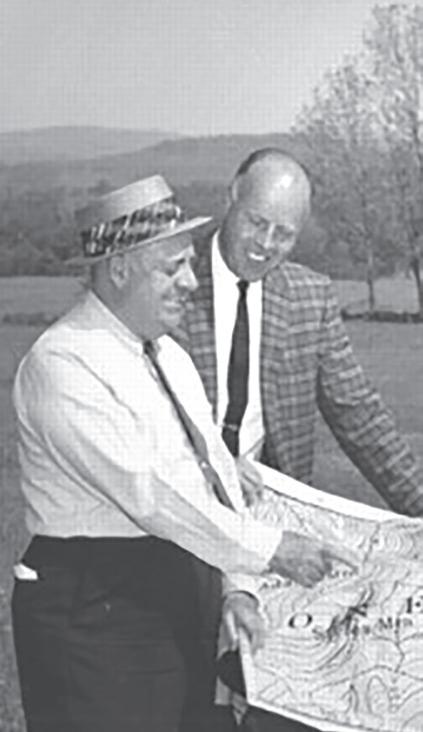
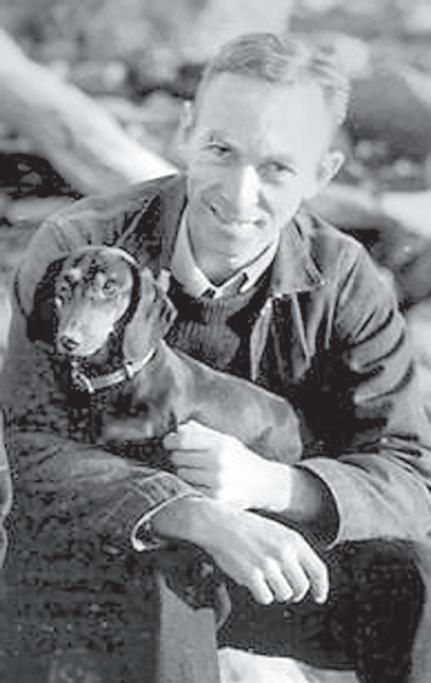
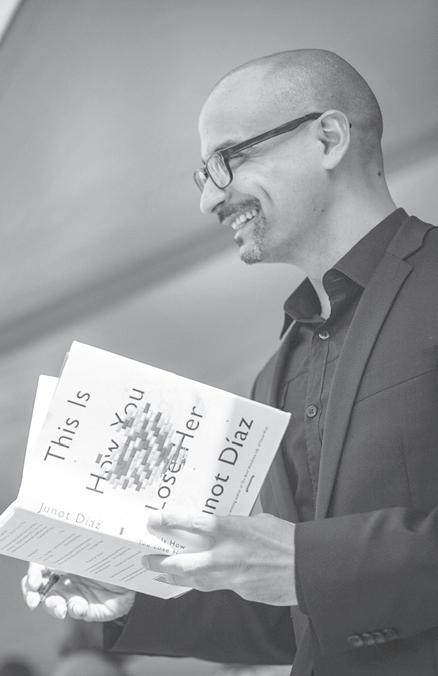
NAME: Robert Trent Jones
GRADUATED: 1931
Visual Arts
NAME: James De La Vega
GRADUATED: B.F.A. 1994
WHAT TO KNOW: This widely-revered, New York-based street artist deals primarily in chalk, creating thought-provoking, aphoristic works that have garnered acclaim not only in the States, but also in Italy and Japan as well. De La Vega has, like any worthy artist, been at the center of controversy. Since, legally, his works qualify as graffiti, he has been taken to court and sentenced on vandalism charges. De La Vega, when not working on his next mural, tours the country as a motivational speaker, talking about freedom of expression, art and working in the face of adversity.
WHAT TO KNOW: While at Cornell, Jones took such disparate courses like landscape architecture, public speaking, agronomy, economics, surveying and hydraulics, to pursue a career as a golf course designer. Jones’ work on over 500 golf courses, including Montauk Downs, Augusta National and Cornell’s own Robert Trent Jones Golf Course, earned him a spot in the World Golf Hall of Fame. Jones’ courses have had an indelible effect on the modern game, encouraging risky play and emphasizing tasteful, original aesthetics.
Literature
NAME: E.B. White
GRADUATED: B.A. 1921
WHAT TO KNOW: White was as dynamic a writer as you could get. A long-time contributor to The New Yorker, White was also responsible for two classic children’s books, Charlotte’s Web and Stuart Little The former Sun editor in chief co-authored one of the definitive guides to English grammar, syntax and style, The Elements of Style, with William Strunk Ph.D. ’96.
NAME: Junot Diaz
GRADUATED: M.F.A. 1995
WHAT TO KNOW: Diaz is a renown writer best known for his short stories. His most famed book titled “The Brief Wondrous Life of Oscar Wao” won the 2008 Pulitzer Prize and the National Book Critics Circle Award. He is now a creative writing professor at the Massachusetts Institute of Technology.
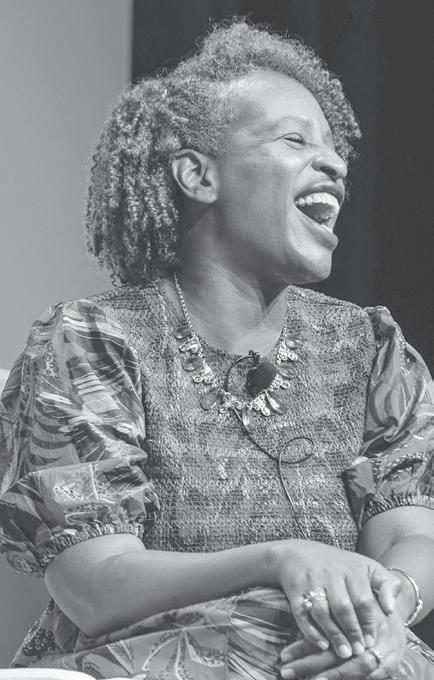
NAME: Nicola Yoon
GRADUATED: B.S. 1994
WHAT TO KNOW: Yoon is a famous Jamaican-American writer best known for her modern books, which have been the subject of many well-known movies, including The Sun is Also a Star and Everything, Everything. Yoon got her great writing skills right here at Cornell.


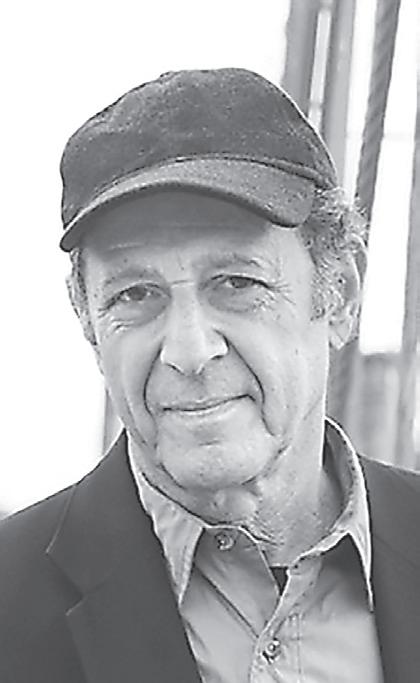

NAME: Peter Eisenmann
GRADUATED: B.Arch. 1955
WHAT TO KNOW: Incoming architecture students are sure to be aware of Eisenmann’s significant contributions to architecture. As one of the leaders of the deconstructivist movement, Eisenmann incited his fellow architects to liberate the form of their works from external references. His works range from convention centers (The Greater Columbus Convention Center) to memorials (The Memorial to the Murdered Jews of Europe) and football stadiums (University of Phoenix Stadium).
Music
NAME: Harry Chapin
GRADUATED: Dropped out in 1964
WHAT TO KNOW: Chapin is a renown for his work as an American singer and songwriter. The performer was best known for his career in filmmaking, and his group that he was part of with his brother, called the Chapin Brothers. Chapin was also active in many charitable causes. While he never graduated from Cornell, he walked the same steps as all of you will.
NAME: Steve Reich
GRADUATED: B.A. 1957
WHAT TO KNOW: Reich’s work as a composer is highly influential across many genres — artists like Sonic Youth, Brian Eno and Sufjan Stevens cite Reich as an influence. Reich’s usage of tape loops, minimalist instrumentation and repetition put him in an elite category of modern composers. Reich was awarded with the Pulitzer Prize for his Double Sextet in 2009.
NAME: Huey Lewis
GRADUATED: Dropped out in 1969
WHAT TO KNOW: A strong rock vocalis and a talented harmonica player, Huey Lewis, the frontman of Huey Lewis and the News, dominated 1980’s radio with his band’s third album, Sports. Lewis also made appearances backing up Elvis Costello on My Aim Is True and playing harmonica on the legendary Thin Lizzy live album, Live and Dangerous
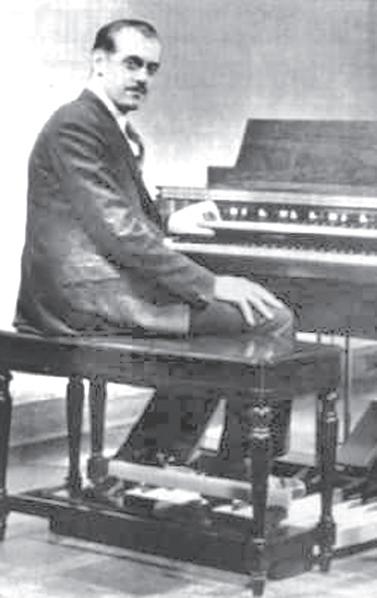
After receiving his B.S. in mechanical engineering in 1916, Hammond would go on to create the electric Hammond organ, which proved to be an important milestone in electronic music’s evolution and influential to the genres of jazz and progressive rock.
THOMAS PYNCHON ’59
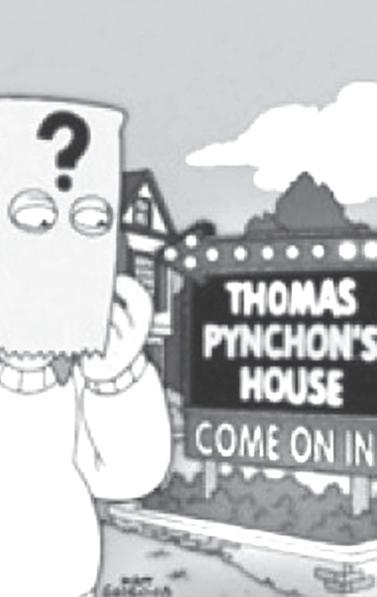
Honing his literary chops under the likes of Vladimir Nabokov at Cornell, Pynchon would go on to define the postmodernist tradition, winning the National Book Award for 1973’s Gravity’s Rainbow
Buck used the skills she honed at Cornell to craft some of the 1930s’ best-selling and most acclaimed historical fiction. She would go on to win a Pulitzer Prize for The Good Earth in 1932 and a Nobel Prize in 1938.
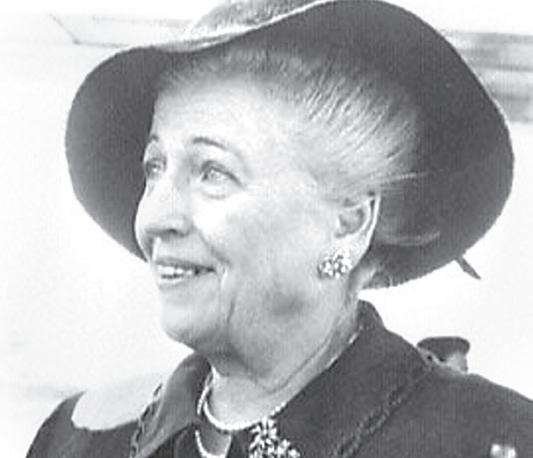
Years after leaving Ithaca with a degree in English, Seidler took the stage to accept the Academy Award for Best Original Screenplay for The King’s Speech in 2011.
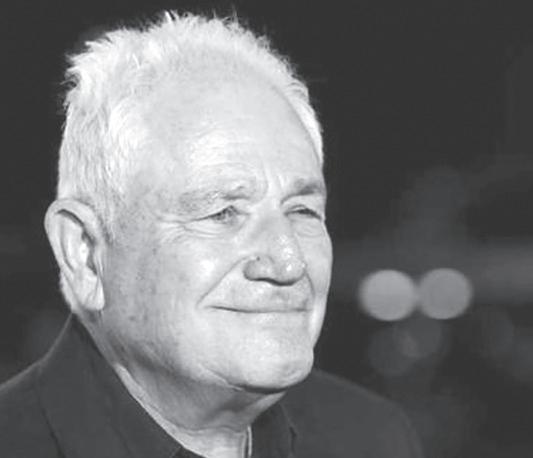
If the origins of popular electronic music can be traced to one person, it would be Robert Moog. While at Cornell studying engineering, he grew interested in and began developing electronic instruments. His Moog Synthesizer would go on to be the tool of choice for everyone from Beaver & Krause to Donna Summer.
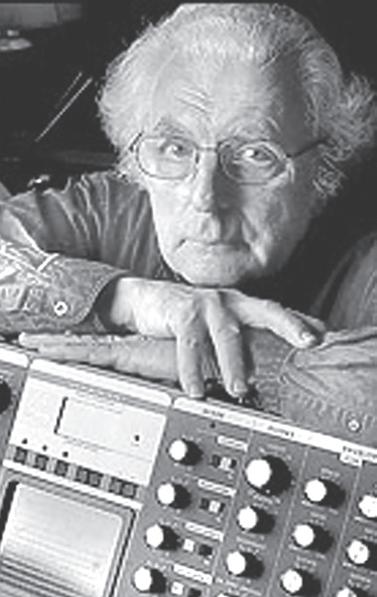

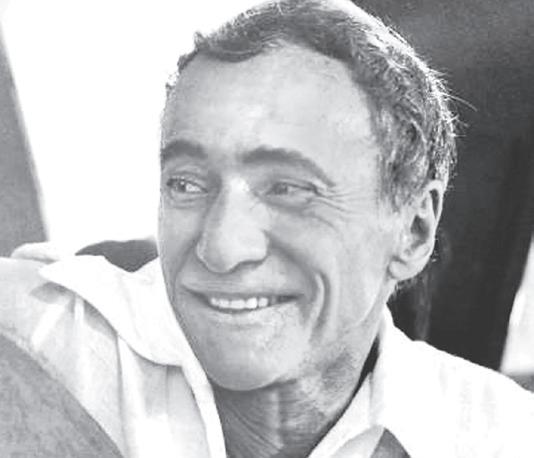
Laurents penned and directed a number of seminal Broadway musicals, including West Side Story, Hallelujah, Baby! and La Cage Aux Folles, in addition to writing a number of well-received films.
TONI MORRISON M.A. ’55
The acclaimed author has won a Pulitzer Prize, the Nobel Prize in Literature and the Presidential Medal of Freedom for her prolific, vivid novels, including Beloved
Before the world knew him as Superman and a philanthropist, Reeve starred in numerous Cornell theater productions.
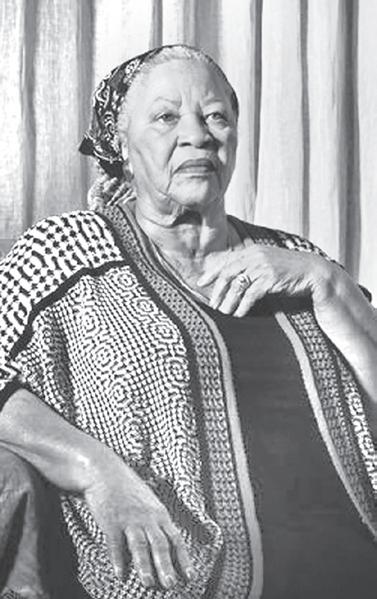
Prior to leaving Cornell to fight in the second World War, Vonnegut pursued a degree in chemistry and served as the associate editor of The Sun. Throughout the 60s and beyond, he established himself as one of counterculture’s most notable novelists with the satirical black humor of books like Slaughterhouse-Five and Cat’s Cradle
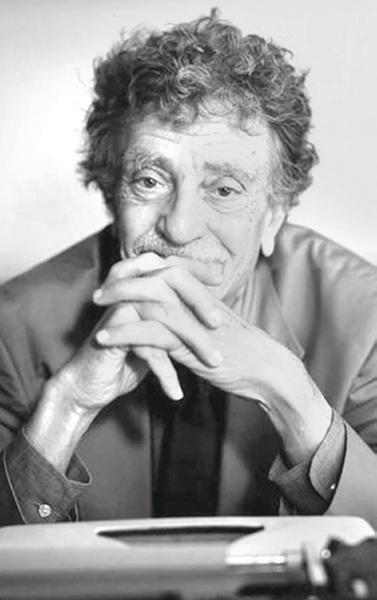
KURT VONNEGUT, JR. ’44
Cornell’s Artistic Legacy
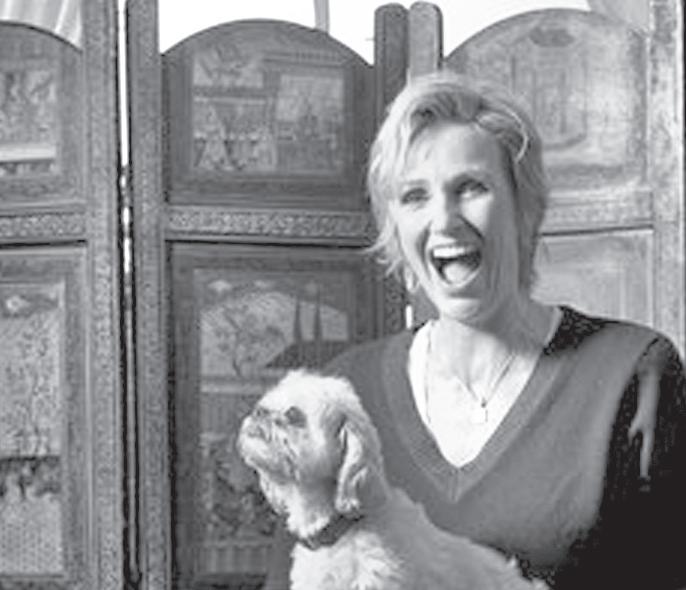
Following a few notable feature-length comedy roles in films such as The 40-Year-Old Virgin and Role Models, Lynch raked in the awards with her regular role on the hit show Glee
After revitalizing the Southern California punk scene, the lead singer of Bad Religion turned his focus to doctoral biology work and has lectured courses on evolution at Cornell.

Through the Years: Concerts at Cornell
For 150 years, Cornellians have come together for live music. From harps to hip-hop, Barton to Bailey and Spring Day to Slope Day, concerts have been a cornerstone of the student experience. Over the years, our campus has been host to violin virtuoso Yehudi Menuhin, the second-most-downloaded Grateful Dead show, Kanye West in support of The College Dropout and everything in between.
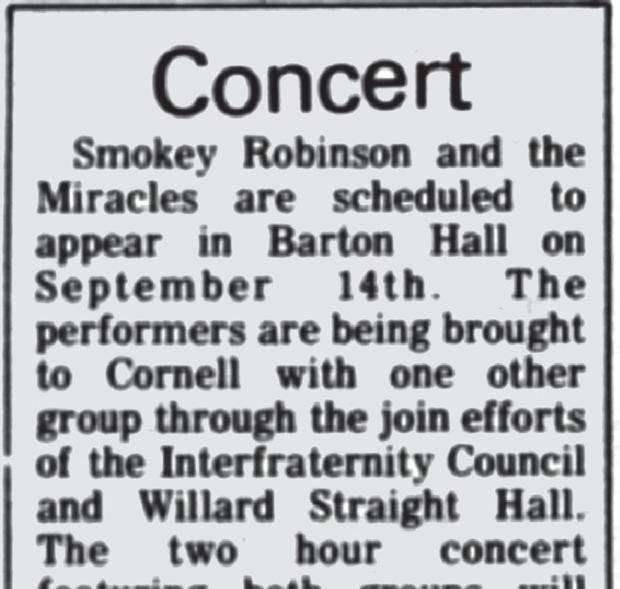
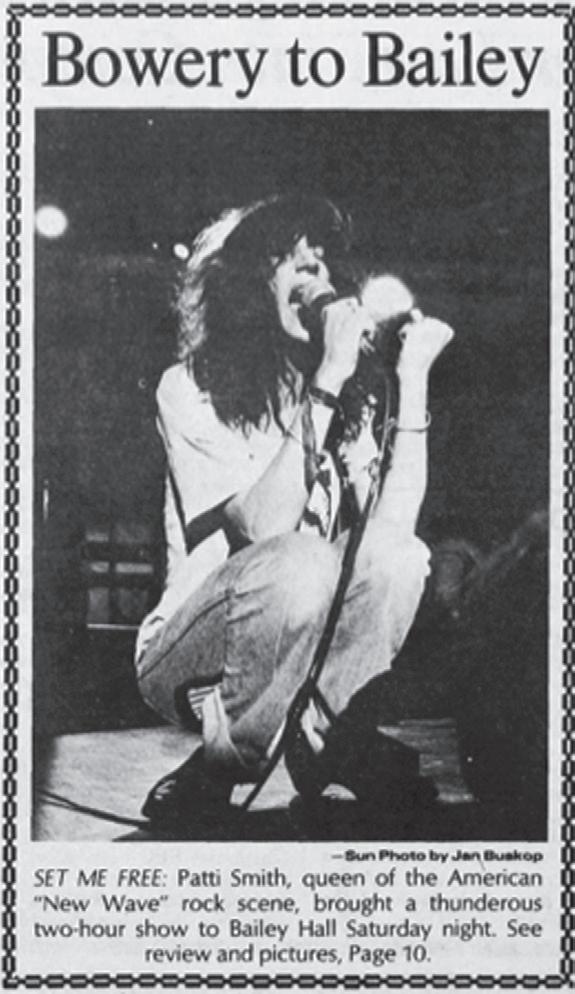

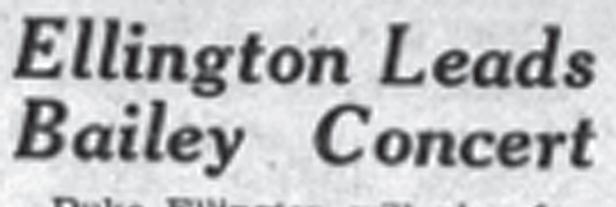
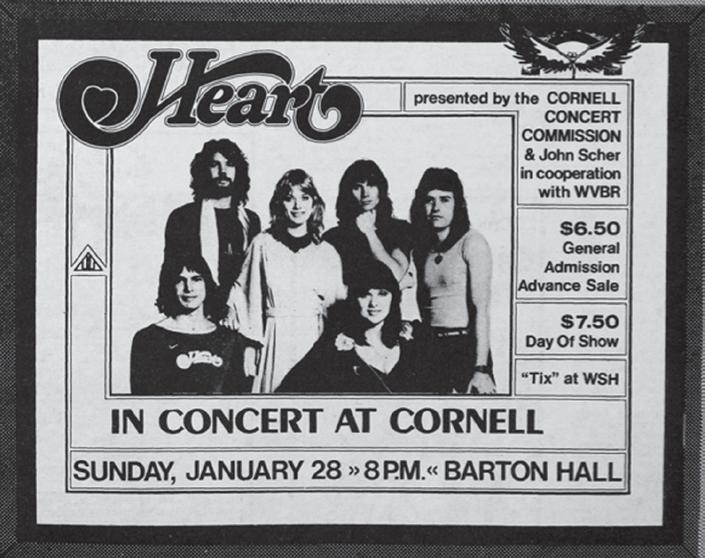
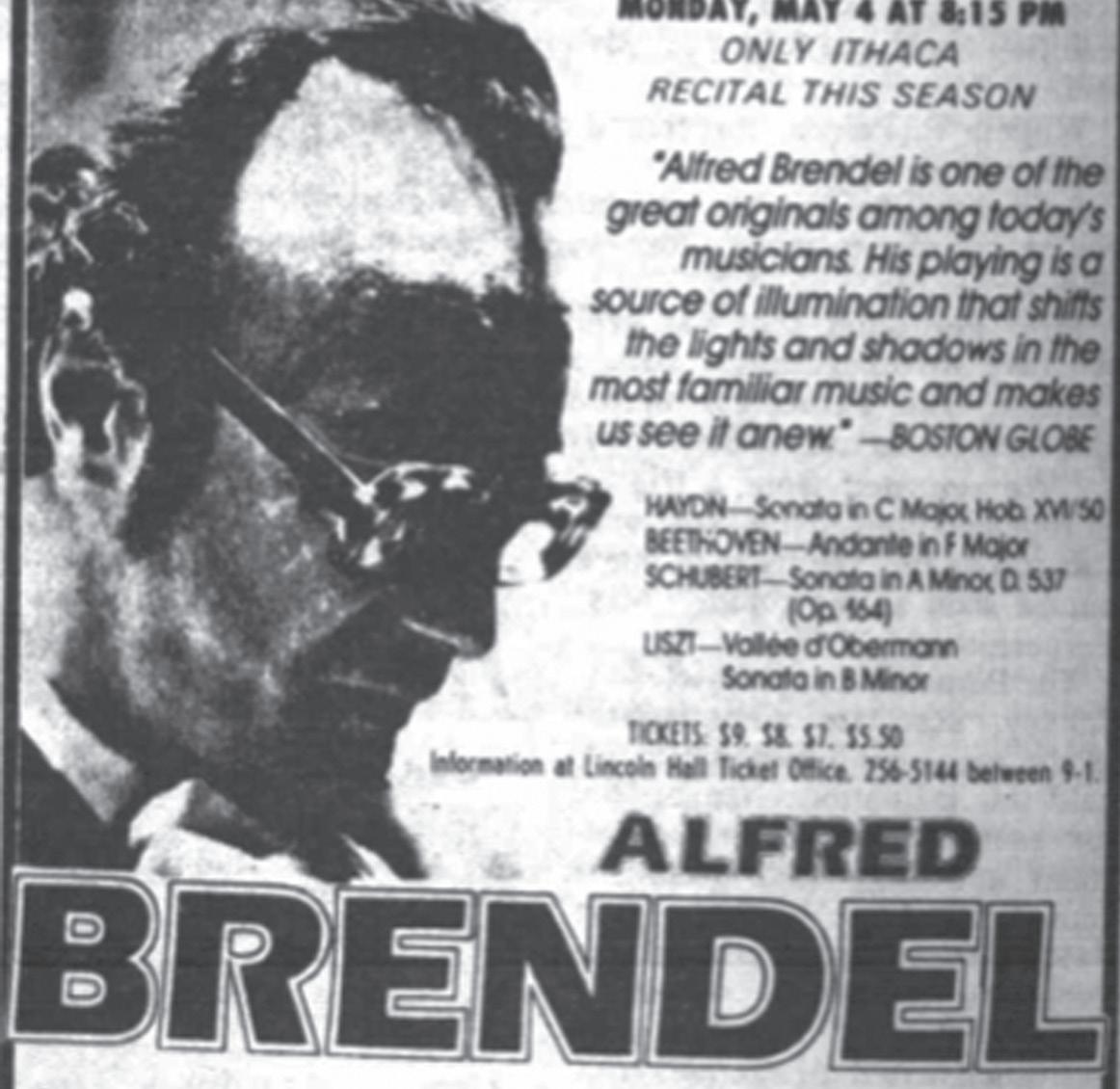

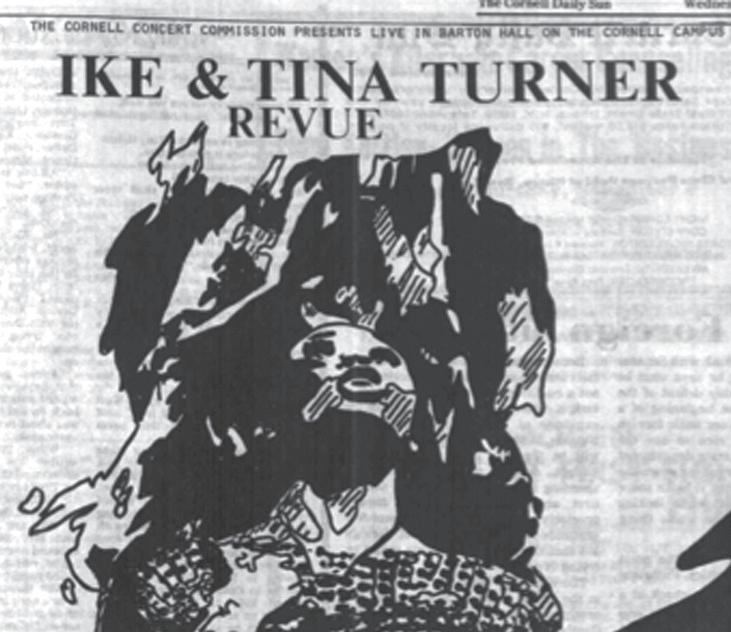
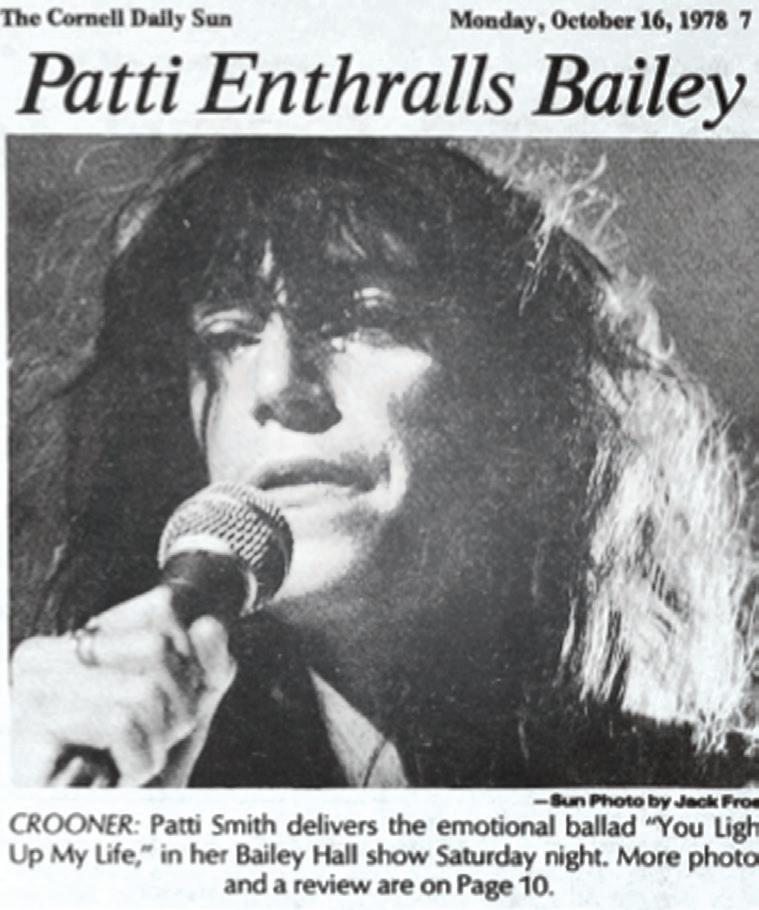

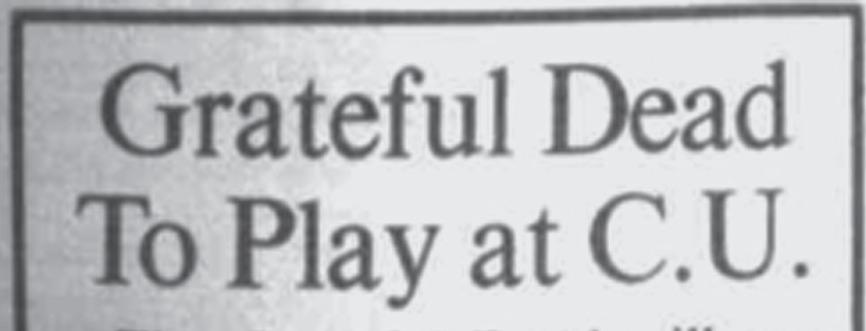

LAURENS HAMMOND 1916
PEARL S. BUCK ’25
ARTHUR LAURENTS ’37
DAVID SEIDLER ’59
ROBERT MOOG Ph.D. ’65
CHRISTOPHER REEVE ’74
GREG GRAFFIN Ph.D. ’03
JANE LYNCH M.F.A. ’84
The Corne¬ Daily Sun
Hidden Meal Plan Hotspots On Campus Morrison vs. North Star
By EIRIAN HUANG Sun Staffer
104 West!
Another dining unit bouncing back post-strike is 104 West!, Cornell’s only Kosher Dining Hall adjacent to the Center For Jewish Living.
104 West! accommodates a variety of religious diets and is open for Shabbat dinners based on when the sunsets throughout the year. Meal swipes, bucks, and most forms of Cornell currency can be used here in addition to credit. Compared to other West dining halls, it’s slightly secluded but reviews unanimously praise this unit for some of the best food on campus.
McCormick’s Restaurant
Although a short walk from RPCC, many North Campus dwellers are unaware of McCormick’s at Moakley House. Named after Cornell varsity golfer Jack McCormick (57’), the golf course eaterie is open weekdays from 11:00 a.m. to 6:00 p.m. They close early at 5:00 p.m. on Saturdays and stay open 9:00 a.m. to 2:00 p.m. for Sunday morning golfers.
The McCormick’s menu features staples from Potato Wedge Poutine and Chicken Wings, unavailable anywhere else near North. Tavern classics like the Moakley Burger or a Loaded Nachos are served daily in addition to an extensive wine and beer list.
BRBs, Cornell Card, and Credit are all accepted here! This fall, your meal plan can afford to take you out on the green.
Big Red Barn
Big Red Barn is certainly no secret, but its quaint rustic exterior may disguise some of the exciting hot sandwich options prepared at this destination. Although serving as the on-campus social center for graduate and professional students, Big Red Barn has become a cozy setting for undergrad coffee chats and interviews. The former carriage house is surrounded by lush trees and hedges on all sides: wooden outdoor sitting tables let students soak in the autumn sun.
At this ideal study spot, signature sandwiches like the Barn’s Cubano and vegetarian Portobello Panini are hot-pressed and served fresh. This unit has soups and baked goods for BRB’s, Cornell Card, and credit. It is open from 8:00 a.m. to 3:00 p.m. every day of the week.
Straight From The Market
Coveted away in a cavern of Willard Straight, Straight From The Market is a delicious dining unit that often flies under the radar. Opened in 2018, this relatively recent eaterie offers a hot dish bar surrounded by salad, fruit medleys, and other enticing cold options. A rotation of daily specials from Paella to Peruvian chicken promise gourmet dishes often unavailable at buffet dining halls.
From 11:00 a.m. to 6:00 p.m., this first-floor hotspot beside Terrace Lounge is a quick-bite goldmine: an army of take-out containers is readily available, and weighed at $8 per pound. If you’re looking to skip the ice cream line at Dairy Bar or dining halls, this joint is stocked with signature Cornell flavors. For BRBs, Cornell Card, and Credit, Straight From The Market is one of few retail locations where berries make a regular appearance.
Gimme! Coffee
Perhaps Cornell’s most beloved local coffee joint, Gimme! Coffee has three locations across Ithaca: one is right here on campus. At Gates Hall, Gimme! has one of the most expansive drink menus, including their addictive Stargazer cold brew and Japanese matcha. Open 11 a.m. to 3 p.m. on weekdays, the coffee roaster was founded in 2000 and re-established in 2022 as a cooperatively owned business. The Gimme! team has focused on ethically sourcing high-quality beans and is credited for an impressive staff of latte artists.
Although this spot is cash and credit only, the lesser-known location may be the perfect place for an on-campus caffeine pick-me-up. As Cornell’s longtime contract with Starbucks expires in June of 2025, the locally-owned vendor is rumored to be a candidate in replacing the espresso magnate.
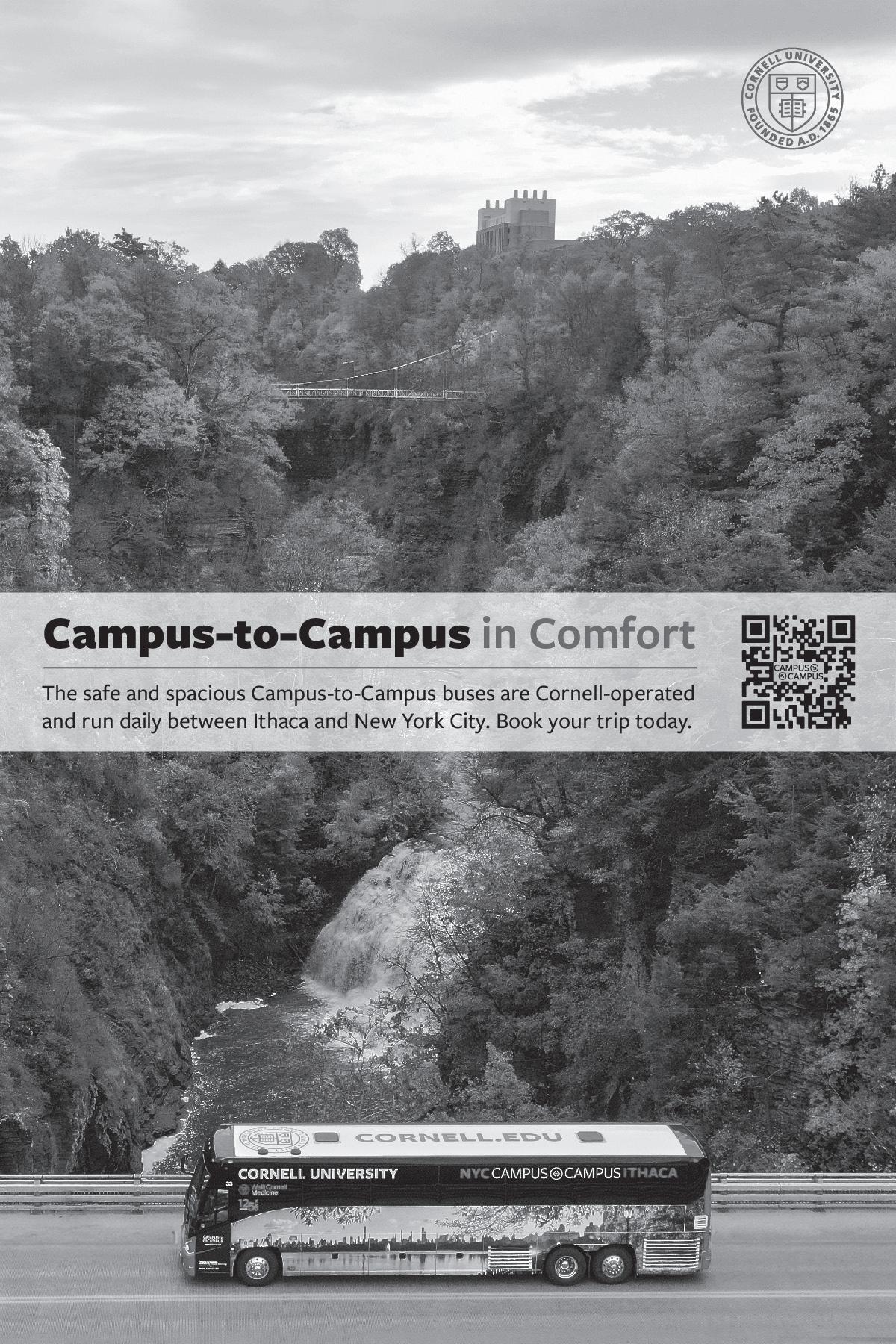
By TAYLOR ELLINGHAUS Sun Contributor
The real question that needs to be answered once and for all is: which is better, Toni Morrison or North Star Dining Hall? While I firmly believe in the philosophy that “West is best,” West is not a convenient walk from North Campus. I find the choice between these dining halls controversial among North Campus dwellers, so I will attempt to lay out the options and settle this debate. a treat worth indulging in!
Atmosphere
Toni Morrison is often described as overwhelming by those who first enter. The size of Morrison Dining Hall can make it feel like an immense collection of food choices to be discovered by Cornell diners. Navigating the different sections and avoiding people walking with a purpose in your direction can be stressful.
The natural light in Morrison makes for a pleasant atmosphere, and it is easy to find seating even when it’s busy. The obvious only issue is the udon noodle line. You know the game where one places dice under a cup and proceeds to shuffle it among other cups until you lose track of where it is? This is the experience of trying to acquire udon noodles at Morrison. In addition, there is a crowd of people in front of you waiting for the same dinner: you typically have to peer over their shoulders to make sure you take your order rather than stealing someone else’s.
North Star, typically also called Appel Dining, can also be overwhelming depending on the time you go, and it is difficult to find seating during the popular dinner dining hours. North Star does not have as modern of an interior as Morrison. Nonetheless, it does have outdoor seating and a beautiful view of campus. The atmosphere in North Star is also great for a late-night meal as it closes at 10 p.m., 2 hours after Morrison.
Breakfast/Brunch
Morrison leads strongly in this category with its waffle makers. Nothing is more disappointing than seeing there is no waffle line just to discover that all of the waffle makers are gone (supposedly broken). Morrison made an extreme comeback, now having three waffle makers, expediting the morning waffle wait. There is a good selection of waffle toppings, such as butter, chocolate syrup and blueberries. The smoothies for breakfast are delicious but are often snatched up and not always available during the entirety of breakfast time.
Meanwhile, the yogurt station’s convenience arguably makes up for a quick breakfast for when you don’t have time to sit and eat. If you’re waking up a little too late for your 9 a.m. class, this might be your best option.
While North Star is not open for weekday breakfast, North Star brunch on a Sunday is a masterpiece. There is a plentiful bounty of baked goods: bagels, muffins, cinnamon twists, and more. The highlight of my Sunday morning is the impeccable chocolate bread pudding. Also coming in strong is the smoothie bowl station, which provides a refreshing addition to a weekend brunch with diverse toppings, from chia seeds to coconut flakes.
A qualm I have against both of these establishments is the lack of breakfast foods on Saturday mornings. Personally, I take breakfast very seriously. The selection on Saturday mornings is very heavy on the “lunch” side of “brunch.” Upon my visit to these dining halls, the only options were potatoes, eggs, and yogurt, which nourished my body but did not nourish my foodie soul.
Lunch
North Star automatically loses in this category since they are only open for dinner. Morrison has had good lunch options, with its astounding loaded baked potato soup. If you have not tried this incredible Cornell dining delicacy, I would highly encourage you to do so. The experience is enhanced when you eat it after trekking through the cold all the way to Morrison after using up almost all of your BRBs.
Dinner
Both Morrison and North Star offer pizza. I would venture to say that North Star’s thick-crust pizza is superior to Morrison’s thin-crust pizza. As a New Yorker, I am hesitant to award undue praise upon a slice of pizza, however, North Star has my seal of approval.
The crowning achievement for North Star, in my opinion, is the bibimbap at the “Create” station.
Morrison usually has selections of East Asian and American Southern cuisine. North Star has broader American comfort food with its grill station, which provides grilled cheese, French fries, and its copycat Chipotle station.
Overall, I would say that both dining halls are good options for a tasty meal. Wherever your heart (or stomach) takes you, we are very lucky to have access to the expansive Cornell Dining system.
Te Sun’s Ice Cream Guide
Cool Down With Ithacan Ice Cream Cool Down With Ithacan Ice Cream
By SUN STAFF

While we believe that Cornell looks the most beautiful at the start of the fall semester, it is also unfortunately the most unbearably hot during that season. To beat the heat and cool down after a back-breaking, sweat-inducing move-in weekend, we recommend heading out for some ice cream, which is also an opportunity to explore the city of Ithaca. Below are three recommendations (in no particular order) for all you incoming freshmen and your families:
If you want to stay on campus and still get some exceptional ice cream, then stop by Cornell Dairy Bar, which actually made a limited edition flavor of ice cream (“Big Red, White & Biden”) in honor of self-proclaimed ice cream fanatic President Joe Biden, who was the Convocation speaker for Class of 2017.
For the past 138 years, Cornell Dairy Bar has been creating ice cream from the university’s cows and currently offers 20 different flavors, some which you’ll notice are offered in our dining halls. If you want to have Cornell Dairy’s entire selection in front of you, then I recommend you pay a visit to Stocking Hall, where the Dairy Bar is located (otherwise, you can find tubs in all campus dining halls). You definitely don’t need to drive a car or take the bus, as it is located on campus and is about a 20-minute walk from North Campus. When you arrive at Stocking Hall, you’ll notice the large, white sculpture of a milk bottle out front.
After trying all 20 flavors, some of our favorites are Bavarian raspberry fudge and Kahlua fudge. Bavarian raspberry fudge is “vanilla custard ice cream with old-fashioned fudge pieces and a raspberry swirl,” and reminds us of raspberry cheesecake. It’s smooth, and the little punches of raspberry and fudge complement each other. Kahlua fudge is “Kahlua ice cream with a chocolate fudge swirl.” Ezra’s morning cup, another Cornell Dairy Bar flavor, also has a coffee flavor, but Kahlua fudge is much stronger and thus satisfying.
Because the Dairy Bar is located in the lobby of Stocking Hall, there’s plenty of seating around the shop. And Stocking Hall was renovated a few years ago, so the place has a casual and modern vibe, given its clean lines and all-white interior.
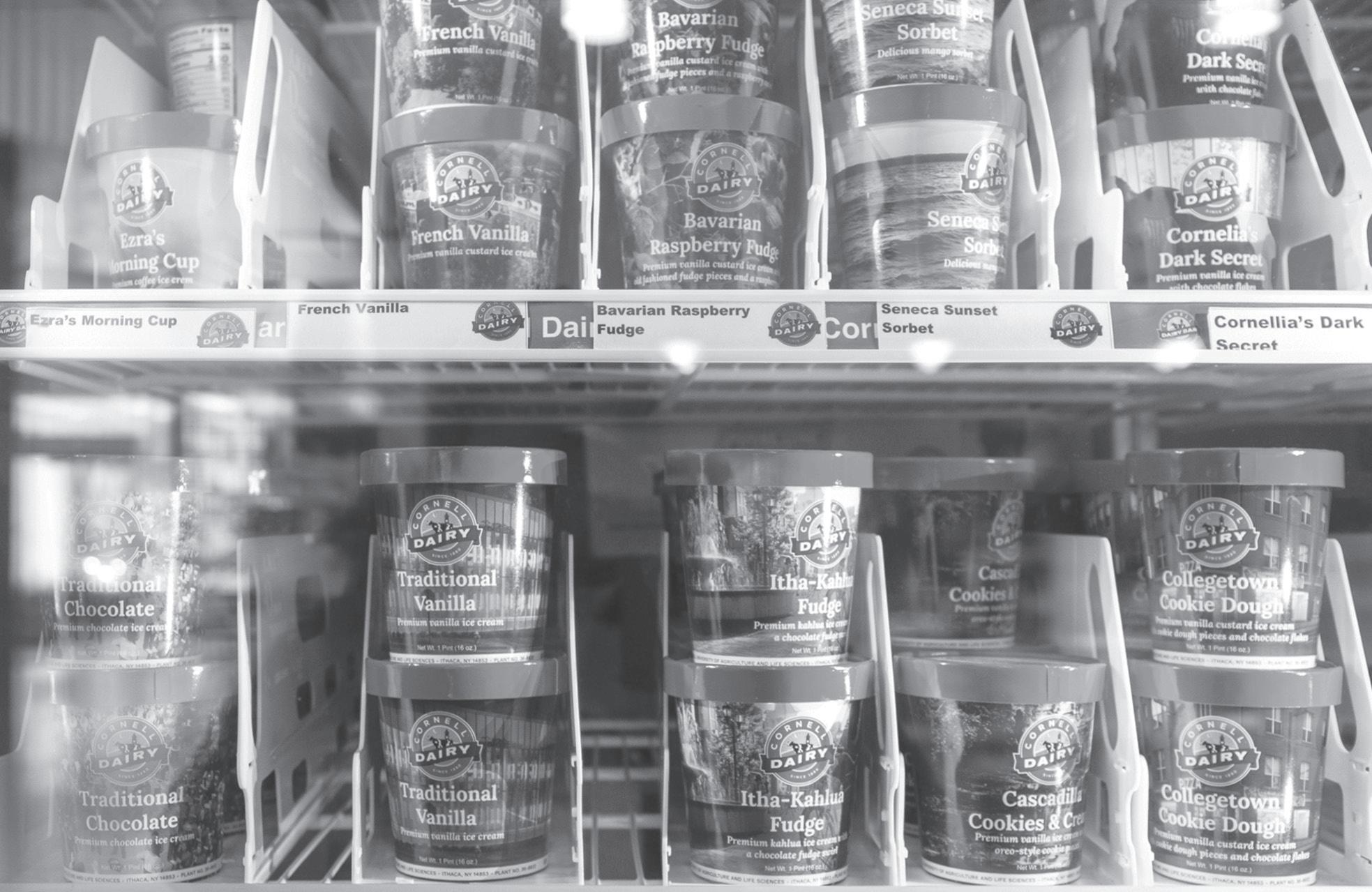
Cayuga Lake Creamery
215 N Cayuga St, Ithaca 8421 State Route 89, Interlaken
Another dessert staple of Ithaca’s food scene is Cayuga Lake Creamery, which has served homemade ice cream flavors in the Ithaca area since 2004. Known for its rich, creamy consistency, Cayuga Lake Creamery typically has 30 flavors of ice cream and sorbet available daily, served on rotation. These flavors range from Cookie Explosion to a Wine Ice Cream Sorbet. Non-dairy vegan options, sorbets, and gluten-free offerings are always available.
We are absolutely over the moo-n or their Purple Cow flavor — a creamy, black raspberry ice cream includes snappy chocolate chunks that refreshingly top off a perfectly sweet cone. Also, it’s signature vibrant color and fun name keep it a classic!
Their sea salt caramel ice cream is well known, and for good reason. The perfect combo of salty and sweet, a match that is absolutely addicting. Another staff pick is the Soy Cherry Jubilee. Enjoyers of Ben & Jerry’s classic Cherry Garcia will
Founded in 1936 by Cornell alum Leo Guentert 1920, Purity Ice Cream may be located the farthest from campus of the three establishments in this list, but it has the greatest variety in terms of both flavors and products.
Of their 34+ flavors of ice cream (some of which are vegan), some of our favorites are bulldog crunch and green tea — good in scoops or blended into milkshakes. According to their menu on Ithaca To Go, bulldog crunch is a “praline-flavored ice cream with caramel swirl and chocolate-covered pecan candies.” This may sound strange, but bulldog crunch is absolutely mouth-watering, even though it’s in liquid form. The caramel and praline flavors are very strong, but the pecans and chocolate balance that creaminess and sweetness with their crunchiness and slight bitterness.
Green tea is much less sweet and made from “green tea powder blended with vanilla ice cream,” which was slightly disappointing because we were hoping it’d be made with real green tea leaves. However, making green tea ice cream with just leaves is quite difficult and can result in a barely detectable flavor. Purity’s use of powder means you get a more concentrated flavor and sometimes there are bits of powder that bunch up together, which could be likened to a swirl.
Besides ice cream, Purity offers frozen yogurt, pastries (cupcakes, pies, cookies and cakes), espresso and milkshakes. If you’re in the mood for more of a meal than a quick dessert, dig into one of Purity’s sundaes. From chocolate chip cookie to apple crisp, the sundaes are warm, gooey and perfectly comforting with scoops of your choice of ice cream and plenty of whipped cream.
Of our recommendations, Purity is also number one in the seating department. With abundant indoor and outdoor seating, Purity is extremely group-friendly, and its logo-covered decorations and booths give the space a relaxed, almost diner-like ambience.
If you can’t find the time to make the drive or take a walk to Purity, no worries — Collegetown Bagels (everyone calls it CTB) usually has six differently flavored tubs of Purity’s ice cream to choose from.

love this one. This ice cream inspires an outdoorsy feeling, and while not overly sweet, it is perfectly creamy nonetheless.
While we love the original Interlaken location, the new Ithaca spot, opened November 2020, has our heart. This Dewitt Mall location offers ice cream, milkshakes, sundaes and novelties as well as indoor seating.
Unlike many of the local ice cream destinations, Cayuga Lake Creamery is open year round. This makes it your perfect destination during Ithaca infamous mid-January false springs.
Seating is both outdoor and indoor at the Dewitt Mall location, and there are wonderful things to say about both. The decor of Ithaca’s Cayuga Lake Creamery is standout, with its cozy warm lighting and a funky indoor porch. However, there’s nothing like an spot on the outdoor porch to people watch in the heart of downtown Ithaca.
In addition to ice cream, the Interlaken roadside location also offers hot food such as soup, grilled cheese, chili, burgers and veggieburgers, even fried clams, and hot coffee. Still, nothing tops their roadside peanut butter ripple and ginger flavors. Enjoy!

CORNELL DAIRY BAR
411 Tower Rd. (Stocking Hall)
PURITY ICE CREAM 700 Cascadilla St.
KATRIEN DE WAARD / FORMER SUN STAFF PHOTOGRAPHER
JULIA NAGEL / FORMER SUN PHOTOGRAPHY EDITOR
JULIA NAGEL / FORMER SUN PHOTOGRAPHY EDITOR
SC I ENCE & TECH
How Cornell Students Are Mobilizing Researchers Nationwide
By ZEINAB FARAJ Sun Assistant Sports Editor
The Trump administration has prioritized federal spending cuts early in President Donald Trump’s second term, led in part by cuts to science research funding at universities across the country. That includes Cornell University, which is reportedly facing more than $1 billion in federal contract cancellations.
In reaction to the federal government’s ongoing attacks on higher education and science research in particular, two second-year graduate students at Cornell, Emma Scales and Isako Di Tomassi, founded the McClintock Letters Initiative, aimed at bringing awareness on a local level to the precarity of science research funding under the current administration and the value that research can yield.
A Call to Action
The group started out of the pair’s desire to collaborate with other advancing science and policy groups across the country to help inform the general public about what scientists do with their research grants. Di Tomassi said the group’s members include scientists who write op-eds, letters to the editor or guest columns for their local hometown newspapers.
“The aim of this group is to share the science that we, as researchers, are doing with taxpayer money,” she said.
Di Tomassi was directly affected by the firing of federal probationary employees — her Ph.D advisor was “illegally terminated” from his position, according to her. She said that a post on NextDoor with over 250
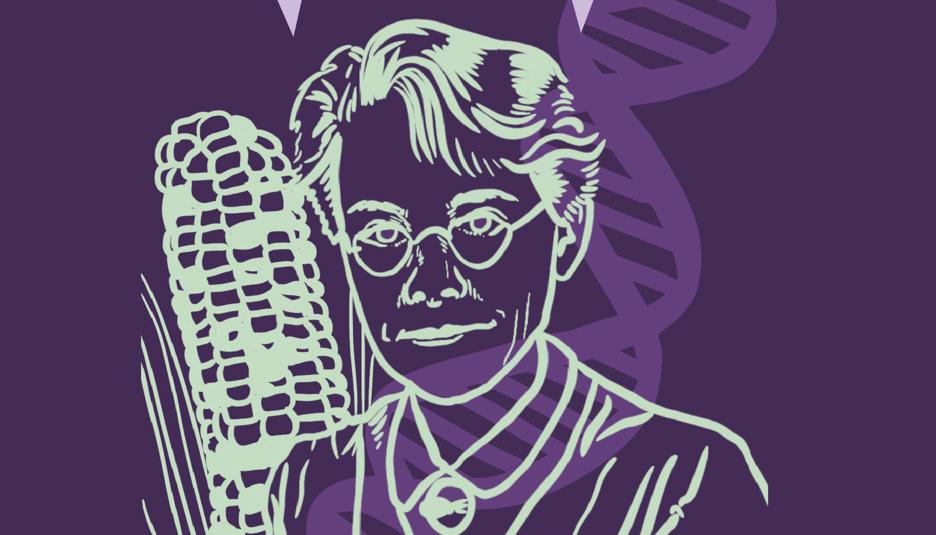
comments of people having “political discourse” and “back and forth conversations” fueled her 0desire to bring awareness to the science that researchers do. Di Tomassi and Scales met with the advisor of the Cornell Advancing Science and Policy, professor Chris Schaffer, and outlined their goals for the initiative.
“It was the perfect mix of us happening to get in contact with several other graduate students’ science policy groups across the country while at the same time we were looking to form some kind of collaboration with the groups [amid] all this federal turmoil going on,” Di Tomassi said.
Through cold emailing and “other means,” Di Tomassi and Scales were able
to unite 20 other graduate student-led science policy organizations from across the nation to join the cause, including from the University of Pennsylvania, Yale University, Johns Hopkins University and the University of California at Los Angeles, among others.
The two chose to name the initiative after Barbara McClintock — a Cornell graduate, genetics researcher and Nobel Prize winner. According to Di Tomassi and Scales, 580 people have signed up to send op-eds to their local newspapers through the group.
Di Tomassi and Scales say that a key to this initiative is publishing all of the pieces simul -
taneously on June 16 — McClintock’s birthday. They picked the date because McClintock did basic research, or discovery-based science, which Scales said is “more vulnerable to attack because its benefits are so long-term oriented.” The group wanted to highlight how crucial this type of research is.
“McClintock was a scientist that made this huge discovery in genetics that had larger applications several decades later,” Scales said, referring to McClintock discovering “jumping genes” or transposable elements. “Figuring out how stuff works biologically is a field of research that is less valued because its applications are not immediate.”
Di Tomassi and Scales explained that the decision to have people publish their op-eds in local newspapers rather than larger media outlets was “super intentional” because they wanted to reach a large audience of Americans.
“Local newspapers are a more authentic way to engage with people,” Scales said. “I think many Americans can really only be reached and spoken to through Americans and it also highlights how important local reporters are and why we need the press.”
Di Tomassi and Scales also emphasized that another reason behind the date and name of the project was that McClintock was a woman who “worked in a male-dominated field” so she “faced a lot of hardship.”
To read the rest of this story, please visit www.cornellsun.com.
‘Research Matters’: Inside Cornell’s Media Campaign Amid Federal Stop-Work Orders, Funding Cuts
By IRIS LIANG Sun Staff Writer
“Research matters,” “Research improves lives” and “Research feeds the world.” These messages have been featured across Cornell’s main webpages and social media accounts, articles and posts highlighting the real-world impacts of the University’s research on pediatric heart assist devices, livestock disease, cryptocurrencies and more.
In the wake of federal research funding cuts and over 120 stop-work orders sent to Cornell by the federal government, the University has dubbed the new media campaign Research Matters.
The Research Matters campaign “aims to illustrate and communicate the value of Cornell research and its realworld impact on national security, the economy, food and agriculture, health care, and technology,” wrote Provost Kavita Bala in a statement sent to The Sun.
Bala explained that the new campaign uses “social media storytelling about how Cornell research improves lives” and highlights some of the “140plus impacted projects, which include research intended to fight disease, protect our military and food supply, develop AI and technology, and advance American competitiveness.”
The campaign includes social media posts featured on LinkedIn, Instagram, X and Facebook, as well as through Cornell Chronicle articles and displays on several Cornell webpages. The banners were altered beginning April 14, based on The Sun’s analysis of previous versions of webpages.
Peer institutions including Harvard, Northwestern and Johns Hopkins have similarly launched research-focused media campaigns in response to the Trump administration’s cuts to academ-
ic research.
Prof. James Antaki, biomedical engineering, said that Bala’s office “hand-selected” his work on PediaFlow, a pediatric heart assist device, to feature in the campaign. The project saw the pulling of a $6.5 million Department of Defense grant, which was supposed to take effect March 31. A video interview highlighting the real-world benefits of the device for infants with heart conditions was published by the Cornell Chronicle on May 6 and promoted on LinkedIn and Instagram.
According to Antaki, the interview generated “sympathetic” media attention from NBC News and The New York Times. Prof. Scott McArt, entomology, said he similarly saw increased publicity following Cornell’s media efforts. He was contacted by NPR, the Washington Post, CNN and The New York Times after his research project on honeybee die-offs — led by the Department of Agriculture and unable to source federal funding since beginning in February — was featured in the Cornell Chronicle.
McArt hopes the campaign helps the public “look under the hood” at academic research.
“I think a lot of the public doesn’t actually realize where their taxpayer money goes,” McArt said.
Prof. Ari Juels, computer science, has his research on blockchain currencies featured on a webpage called “International Research Matters for the United States,” which was added to the Einaudi Center for International Studies website on May 12, according to an analysis from The Sun. Juels believes that the “ivory tower view of academia” is a misconception stemming from universities’ failing to advertise the global impacts of research to the broader public.
Juels hopes for Research Matters to
“rebuild trust” in academic research, not just among policymakers in the wake of current research stop-work orders, but among the general public and private industry — another source of potential research partnerships — in the long term. Along with colleagues, Juels is producing an external opinion piece highlighting academia’s contribution of “foundational ideas and concepts” to the blockchain industry, and the “clear
“Private industry is not going to fund these high-risk, high-reward ventures,” Antaki said.
“What if that private donor didn’t exist?” McArt said, referring to a private beekeeper who reimbursed the $80,000 worth of honeybee disease analyses Cornell’s Dyce Lab for Honey Bee Studies — for which he is program director — conducted in the absence of federal funding.
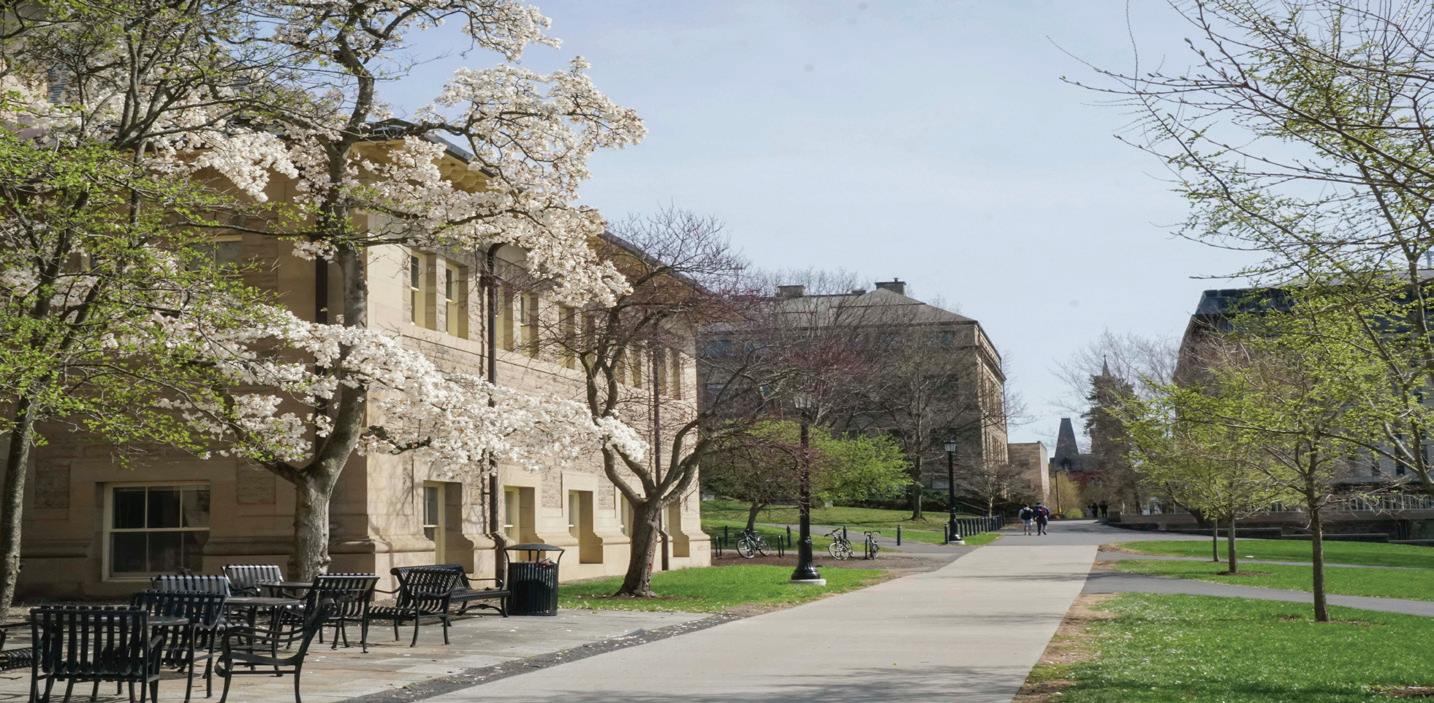
Ithaca is Impact| Cornell’s campuses do research that impacts the world.
economic impact” research has driven by generating multi-billion dollar companies.
Prof. Elad Tako, food science, says bringing awareness and a return of funding through Research Matters is also crucial for “teaching and training the next generation of scientists.” Recruitment of student researchers for the upcoming fall semester is “very limited” due to the work stoppages, he explained.
Although several researchers told The Sun they sourced private savings and donors to continue their projects, they underscored the dependence of Cornell’s research on federal funding.
Looking forward, the researchers said they believe that Research Matters is unlikely to directly impact this year’s federal budget cuts. However, Antaki hopes that making research accessible to the general public can generate lasting support for projects at Cornell and their “worthwhile benefit to society.” He warned against the “flash in the pan” reaction to his featured interview, with initial attention on LinkedIn and Instagram tapering off. “Hopefully the campaign is able to keep up momentum,” Antaki said.
Juels reaffirmed the importance of research to the United States.
McClintock Is The Muse | Cornell researchers were inspired by graduate and researcher Barbara McClintock.
COURTESY OF EMMA SCALES
SOPHIA ROMANOV / SUN STAFF PHOTOGRAPHER
No. 7 Wrestling Places Tree All-Americans Women’s Hockey’s
By DYLAN GRAFF Sun Assistant Sports Editor
This article was originally published May 8.
As the final whistle blew in their matches, three Cornell wrestlers made their way to the center of the mat, heads held high and arms raised in victory.
The road was far from easy, but senior Chris Foca, sophomore Meyer Shapiro and freshman Simon Ruiz had all earned their places among the nation’s best, each placing fifth in the country in their respective weight classes — and securing All-American honors at the National Collegiate Athletics Association Championships. Additionally, for the first time in Cornell wrestling history, all ten starting wrestlers won a match in the tournament.
“It was history for Cornell,” said head coach Mike Grey ’11. “We had all 10 wrestlers win a match and score points, which is really, really exciting. We had six brand new starters in the lineup, so our team is really young. We lose one AllAmerican, but we have two All-Americans coming back. We have a ton of youth, and we’re going to be dangerous in the future.”
Shapiro, who entered the tournament seeded second, wrestled with the intensity and precision that has made him so dangerous all year. However, in the semifinals, he faced his toughest challenge yet against Nebraska’s No. 3 Antrell Taylor, the eventual champion, who defeated Shapiro 7-2.
In the consolation match that could have sent him to the third place match, Shapiro was matched up against Pennsylvania State University’s No. 1 Tyler Kasak. The match came down to a takedown, with Shapiro ultimately losing 5-2. In the fifth place match, Shapiro handled University of Northern Colorado’s No. 7 Vincent Zerban, winning 11-0.
What made Shapiro’s performance extraordinary was the fact that, following his win, he revealed he had suffered multiple seizures and even had fallen into a coma just a month before the tournament. The fact that he was able to compete at such a high level after such a traumatic experience was nothing short of remarkable.
“It’s a testament to him as a person, his resiliency, his competitiveness, his ability to deal with adversity,” Grey said. “That’s the meaning of sport. He learned so much about himself this year that’s going to translate to later on in life: the ability to deal with some really serious setbacks, move forward and not make excuses. Making excuses is how you fail. So not making excuses and just pushing forward — [Shapiro] did a great job of that this year.”
Foca, a seasoned veteran, showed his trademark moxie
throughout the tournament. After a strong start, Foca found himself in a tightly contested match against University of Minnesota’s No. 3 Max McEnnelly that ended with a narrow 10-7 loss for Foca. Undeterred, Foca powered through the consolation rounds, securing his spot in the fifth-place match.
Foca’s experience and mental toughness were on full display as he sealed a 7-4 victory over Maryland’s No. 8 Jaxon Smith. The match marked Foca’s last time representing the Red, and while Foca said he had hoped to go further in the tournament, he certainly went out on a high note.
“[Foca] will go down as somebody who’s super entertaining,” Grey said. “His matches are always wild and fun, and he’s definitely a crowd pleaser here at Cornell. ment, and he did exactly that.”
other wrestlers in the top 100.
To continue reading this article, please visit www. cornellsun.com.
’25 Selected No. 5 in PWHL Draft
By JANE McNALLY and ELI FASTIFF Sun Senior Editors
This article was originally published June 24.
For the second year in a row, Doug Derraugh ’91 and the Cornell women’s hockey program have produced a selection in the Professional Women’s Hockey League Draft. This year — for the first time — that player is a first round draft pick.
Rory Guilday ’25 was selected with the fifth pick by the Ottawa Charge in the 2025 draft’s opening round held at the Hard Rock Hotel & Casino in Ottawa, Ontario. Guilday is set to join Brianne Jenner ’15 in Canada’s capital city, as well as the five other Cornell alumnae in the league..
“It’s pretty special,” Guilday said about being selected in front of the Ottawa Charge fans. “Especially to be surrounded by these people and this crowd. It makes me that much more excited.”
The selection of Guilday rounded out the top five picks in the draft, with four of the five selections coming from ECAC teams.
Guilday was widely projected to be taken early in the draft due to her impressive collegiate and international resume. On East Hill, the Minnesota native provided a steadying force
defensively all four years, while tallying 52 career points for Cornell. During her senior year, she helped power Cornell to its first ECAC title since 2014 and was named Third Team All-ECAC. Guilday also brings plenty of international experience to the PWHL. Not only has she played in 38 career games for Team USA, but she has also been a part of three Women’s World Championship medals and a Six Nations Tournament title.
At 5’ 11”, Guilday has earned a reputation as a dominant defender thanks to both her size and her smart play. The Sun’s 2025 Female Athlete of the Year does the little things right defensively — such as closing passing lanes and keeping her head up on defense — while also earning praise for her ability to use her physical style of play without drawing the ire of referees.
Offensively, Guilday has not produced at the rate of other defenders such as Haley Winn and Nicole Gosling (who were drafted second and fourth overall respectively), but her slapshot ranked among the hardest in the NCAA and even had its own play in Cornell’s offense.
To continue reading this article, please visit www.cornellsun.com.

No Losses, No Draws and an
NCAA National Championship
Looking Back at Red Hockey’s Unparalleled 1969-70 Season
By LUKE PICHINI Former Sun Sports Editor
This story was originally published on March 4, 2021.
In one of the most outstanding efforts by an NCAA men’s hockey team, Cornell became the first — and so far, only — men’s hockey team to capture a national championship during the 1969-70 season without suffering a single loss or draw.
Cornell’s incredible 29-0-0 campaign began with an 8-2 stomping of Western Ontario, and from there, the Red continued to dominate, closing the first stretch of the season on a seven-game winning streak.
The lone scare came in a road matchup against Brown, when Cornell eked out a 5-4 overtime victory. Despite staring at a one-goal deficit in the third period, junior forward Brian McCutcheon came up with a power-play score to force an additional period of play.
The ensuing overtime period ended after a mere 34 seconds thanks to senior defenseman Dan Lodboa, who forced a Brown turnover and then found the back of the net. The Red’s victory in this contest became only one of five contests during the entire season that was decided by one goal.
Staying Hot
During the holiday season, Cornell continued its hot streak, picking up victories over familiar foes, including Rensselaer, St. Lawrence, Boston University and Colgate. In that slate, the Red outscored its opponents, 25-6, including a 9-0 blowout of Rensselaer.
As the Red entered the conference portion of the regular season, it only maintained its dominance. Aside from a 2-1
victory at Toronto, Cornell rarely endured close games. While its home showdown against Dartmouth only ended in a 3-2 decision in favor of the Red and was certainly an exception, Cornell walloped that same opponent a week and a half later, shellacking the Green by a 14-0 margin.
In that 14-0 blowout, 17 different players tallied at least one point, with junior forward Bob Aitchison leading the way with five points, despite having entered the contest with only two goals on the season.
Playoff Challenges
Though Cornell encountered tough challenges from several of its opponents over the course of the season, the team entered the ECAC Championship on an offensive roll, having scored a whopping 41 goals during the final four games of the regular season.
That momentum carried over in the first round of the ECAC playoffs with a 6-1 beatdown of St. Lawrence. In the next round, though, the Red faced a much stiffer test in the form of the rival Crimson. In the span of just four minutes, Harvard’s attack came alive, beating junior netminder Brian Cropper three times to put the Crimson up 3-1, marking the first time all season the Red trailed by two goals.
Cornell buckled down, responding with four straight goals, but Harvard quickly scored two of its own to make it 5-5 in the final frame. But a penalty was called on the Crimson after its fifth goal, and sophomore forward Larry Fullan capitalized on the ensuing power play, giving the Red a 6-5 lead that it never relinquished.
Having claimed victory in the last three ECAC Championships,
Cornell sought a fourth title, but it would have to first defeat Clarkson to achieve that honor. Like its previous game against Harvard, the Red fought hard to grind out a victory.
In a back-and-forth contest
Tournament against Wisconsin, the Red faced an initial deficit after the Badgers scored an early goal.
But in the final two frames, Cornell completely smothered the Badgers’ offense, only con-
national title game.
During the first two periods, the teams alternated leads before the Red pulled away in the last period. Buoyed by Lodboa’s three third-period goals, Cornell secured a 6-4 vic-
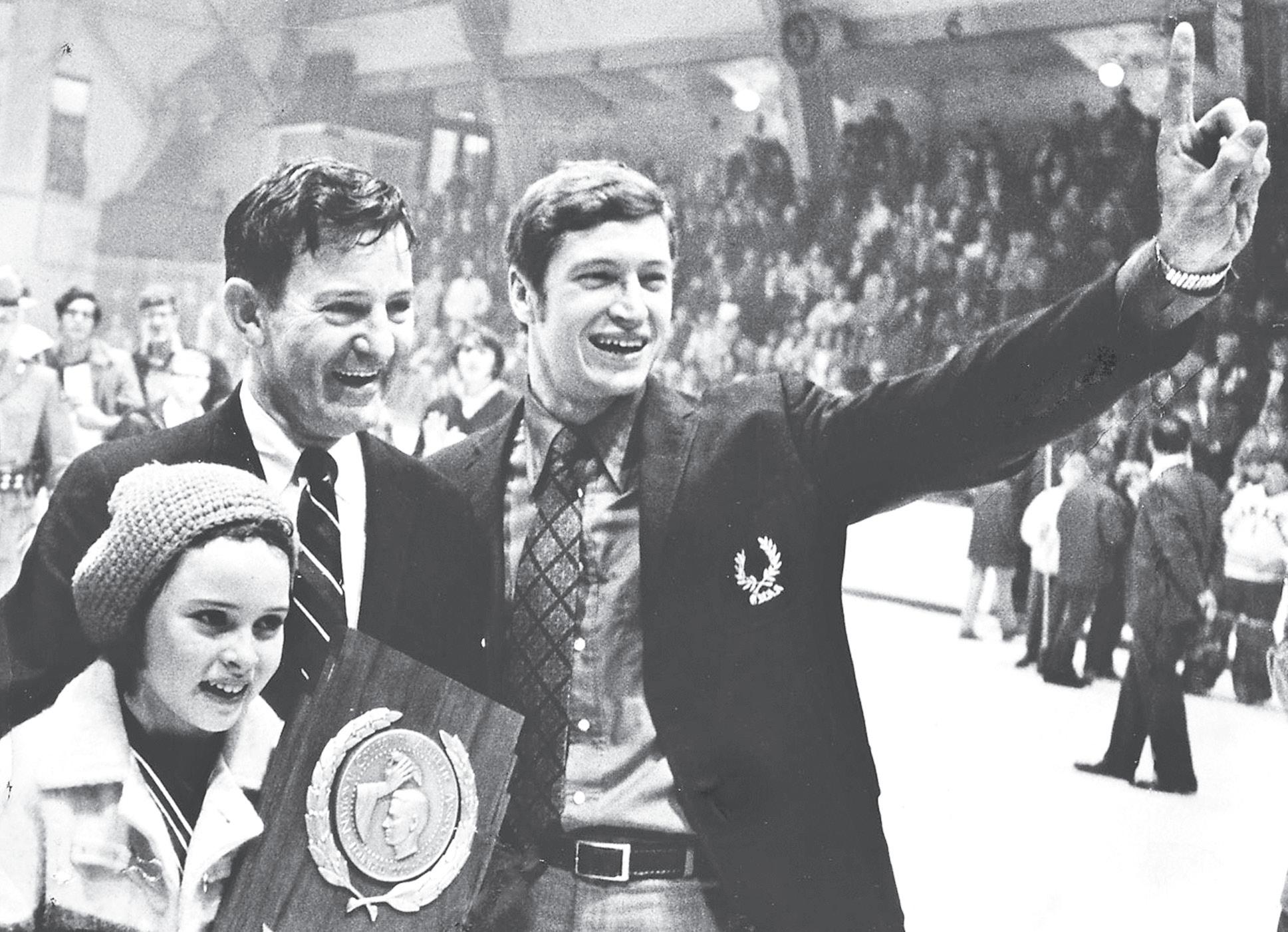
between two exceptional goalies, Cropper and Clarkson’s Bruce Bullock, it was ultimately Cropper and the Red who prevailed. With the game tied at two apiece, senior forward John Hughes fired a shot past Bullock in the waning seconds of the third period, clinching the Red’s fourth straight ECAC title.
Final Hurdles
With a perfect regular season under its belt, Cornell only had two more opponents in its way of achieving national glory. In the first contest of the NCAA
ceding four shots. Meanwhile, the Red finally broke through in the third period, notching two goals against Wisconsin goaltender Wayne Thomas to vault itself into the National Championship game.
Cornell’s final opponent was a familiar titan — Clarkson. The Golden Knights hoped to avenge their loss in the ECAC title game and spoil the Red’s perfect season in Lake Placid. In the early going, Clarkson appeared on track to do just that, scoring in the first 20 seconds of the
tory over Clarkson, clinching the program’s second national title while also etching its name in NCAA history by becoming the only undefeated national champion.
Unmatched
In the years since, Cornell has retained a strong program, especially under head coach Mike Schafer ’86. Still, it remains fairly unlikely that the Red — let alone any other NCAA men’s hockey squad — will be able to achieve the same heights of the 1969-70 Cornell team.
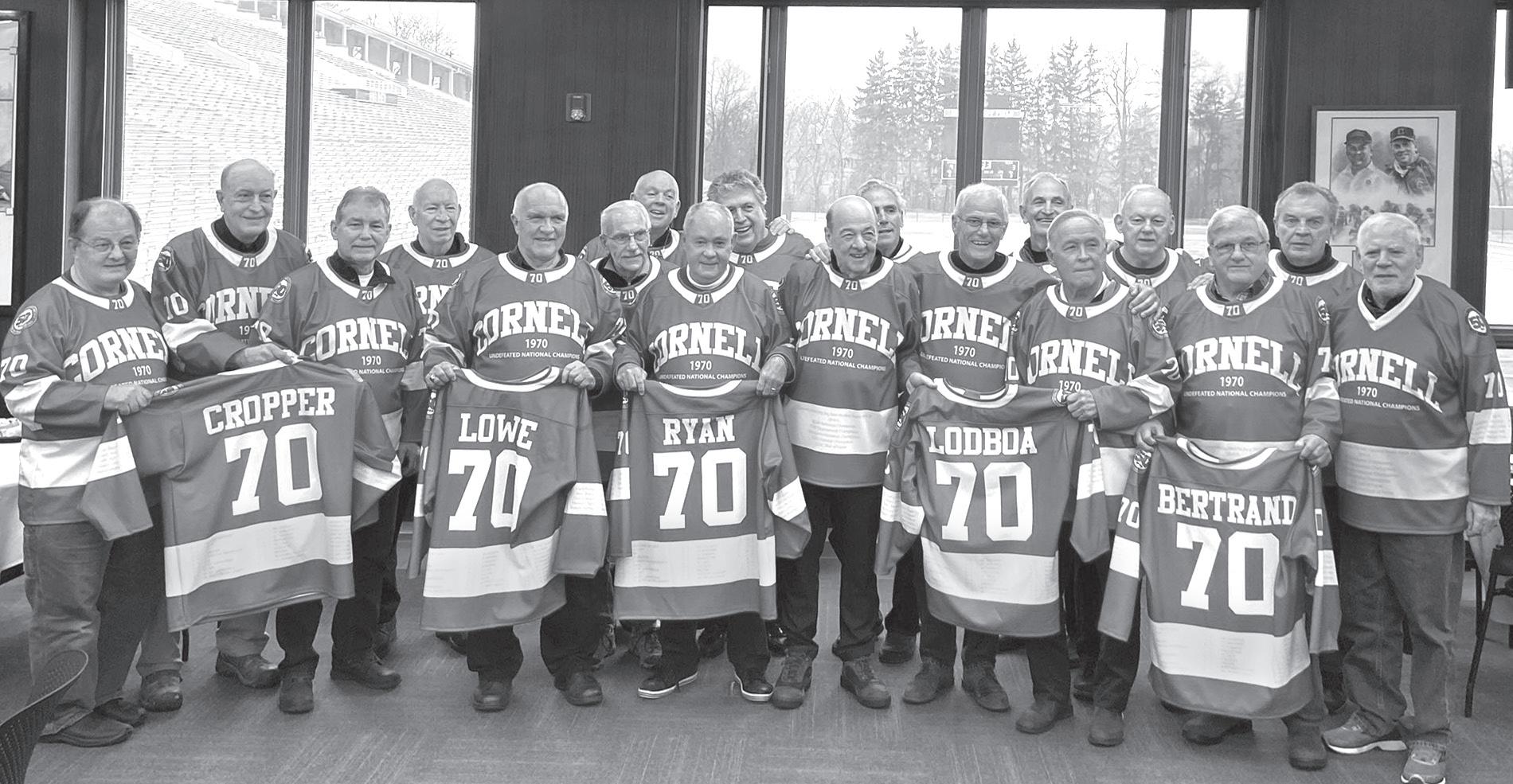
Going out on top | Head coach Ned Harkness (top left, with daughter below) celebrates leading the Red to its second national title on March 21, 1970. Gesturing “number one” is future head coach Dick Bertrand ’70.
Reunited | The 1969-70 men’s hockey team reunites at Cornell in January 2020 to celebrate the 50th anniversary of its historic season.
Recalling 1940’s ‘Fifth-Down’ Dartmouth Game
Cornell concedes loss after flm shows its winning play was down fve
By RAPHY GENDLER Former Sun Sports Editor
This story was originally published on Nov. 17, 2020.
In the 21st century, most Cornell-Dartmouth football games don’t make national head lines. But 80 years ago, in Hanover, New Hampshire, on Nov. 16, 1940, in what commentators called a stunning display of sportsmanship, Cornell — then the top team in the country, rid ing a 19-game win ning streak — gave away an apparent 7-3 win after realizing its last-second touchdown was scored on fifth down.
The Red entered the game against its longtime rival — then called the Indians — riding an 18-game winning streak dating back two seasons. Dartmouth broke a scoreless tie with a fourth-quarter field goal, taking a 3-0 lead.
The Wikipedia page for the game reports that Cornell got the ball on the Dartmouth six-yard line with less than a minute to play. After short gains on first and second down, Cornell had the ball on the one-yard line. A run for no gain on third down followed by a delay of game penalty gave Cornell fourth down from around the five-yard line.
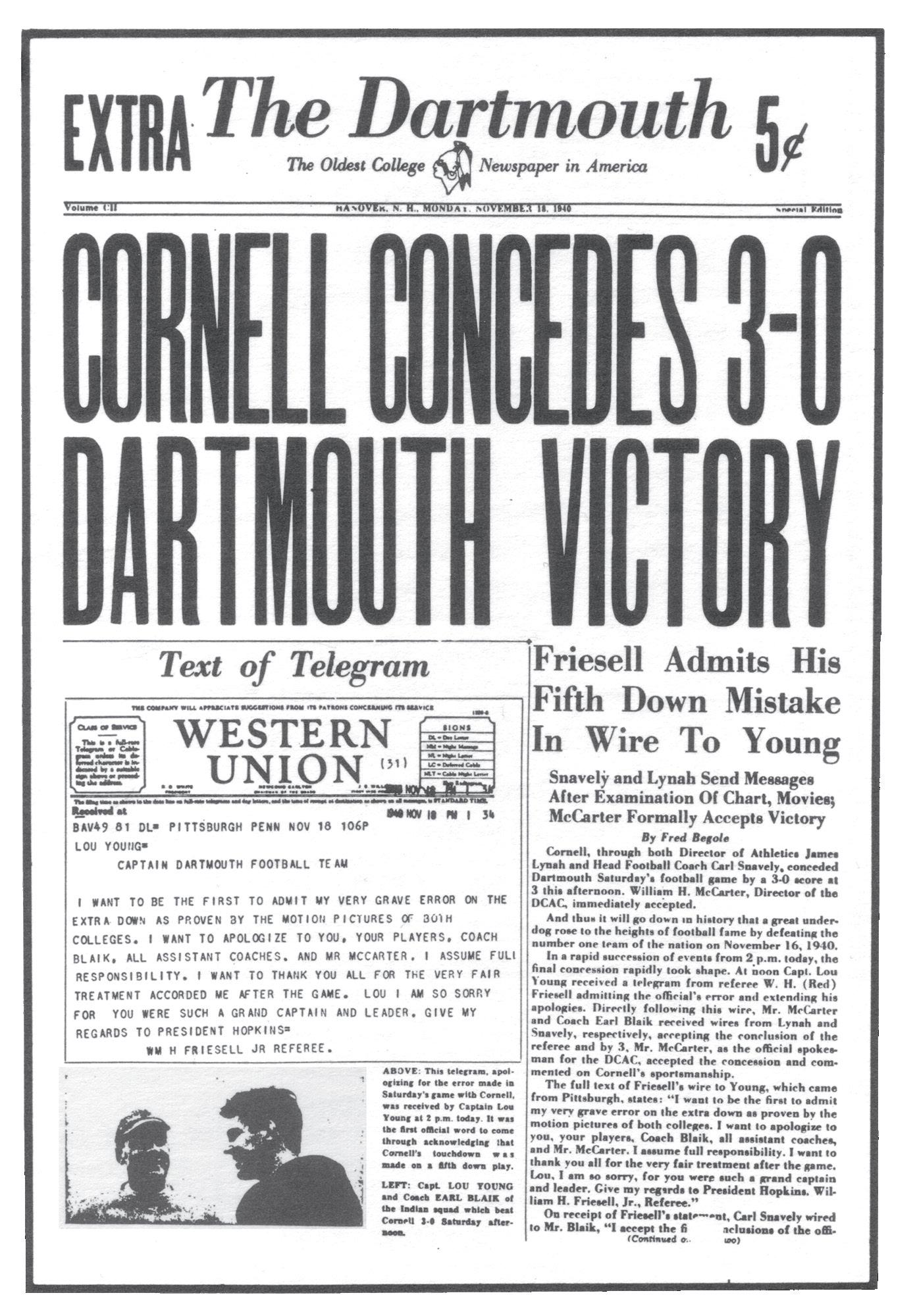
Scholl ’41 threw an incomplete pass into the end zone. And that should’ve been it. But the referee signalled fourth down, and Scholl
found receiver William Murphy for a touchdown on the bonus down. Cornell won the game 7-3. Or so they thought. After reviewing film of the game on Sunday, coach Carl Snavely and Cornell officials realized the touchdown shouldn’t have happened. So they sent a telegram to Hanover offering to forfeit the game. Dartmouth accepted, cementing the contest as a 3-0
Edmund Ezra Day, then the president of Cornell, was a Dartmouth graduate. Lou Conti ’41, a guard on the 1940 team, told The Los Angeles Times in 2010 that Day said, “You can offer them the game, but they won’t accept
“We didn’t believe that. I didn’t believe that. Nobody believed that they would not accept the game,” Conti said.
Frank “Bud”
sportsmanship’ — and they were 100 percent right,” Conti, then 91 years old, said in 2010. “But if I had been a grown person with some authority, I never would have offered to give the game away.”
“I can just remember my father telling me. He said, ‘Son, they will never remember that you guys were undefeated and that you had the greatest team in the nation. But they’ll never, never forget that your college awarded that game back to Dartmouth.’”
Frank Finneran
’41
At the time, an angry team and football-obsessed campus felt like the game had been unjustly stolen, even as praise for the act of sportsmanship came from around the country: A New York Herald Tribune editorial said “there seems again to be hope in the world.”
Some players on the 1940 team insisted that Mort Landsberg ’41 got into the end zone on his third-down run that was marked just shy of the goal line. And while decades later they looked back fondly on the forfeit, at the time they couldn’t believe their university would give the win away.
“The pride is now. It wasn’t then,” said Frank Finneran ’41, a guard and defensive lineman on the 1940 team. “I can just remember my father telling me. He said, ‘Son, they will never remember that you guys were undefeated and that you had the greatest team in the nation. But they’ll never, never forget that your college awarded that game back to Dartmouth.’”

Eighty years later, the Fifth-Down Game still stands alone in college football history: No other game has been decided off the field after its conclusion. A 1940 editorial in The Sun said “our honor and good name remain
Decades later | This play took place during the Cornell-Dartmouth football game on Nov. 10, 2018 — 72 years after the “FifthDown” football concession.


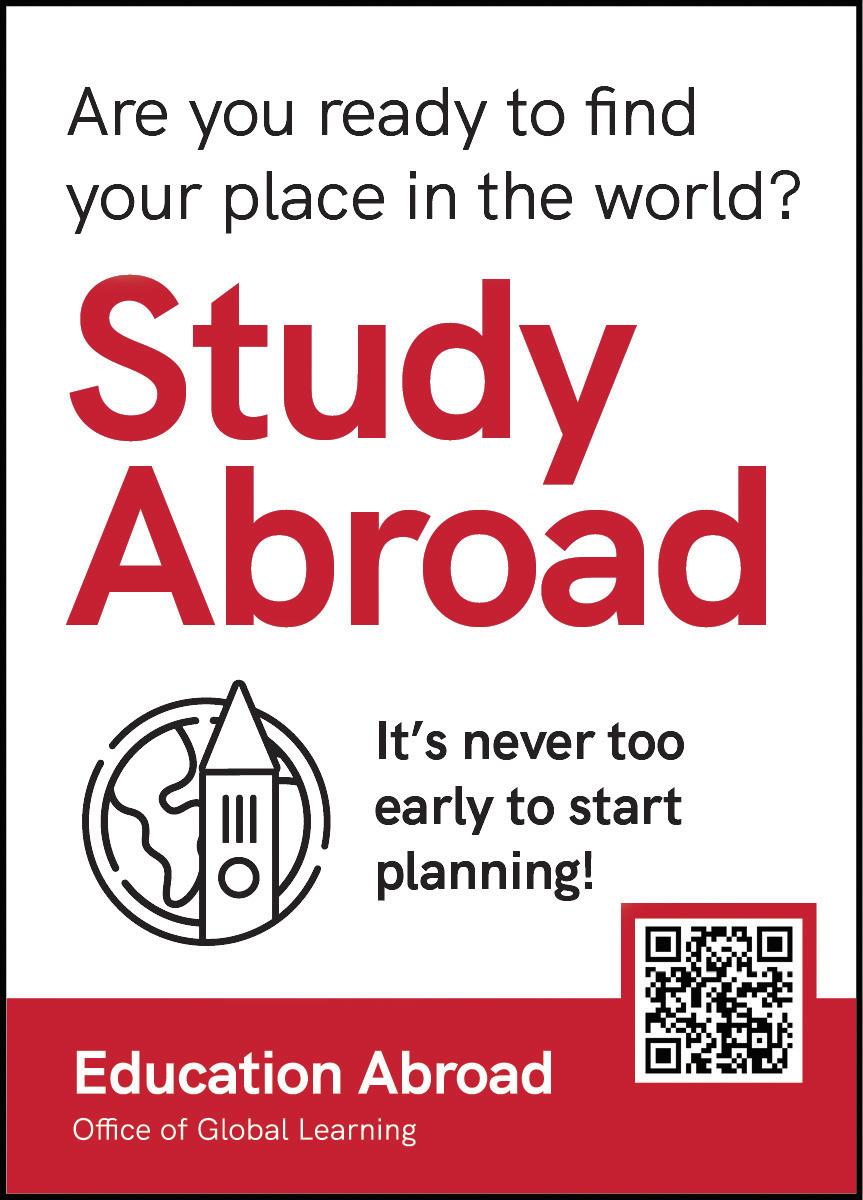
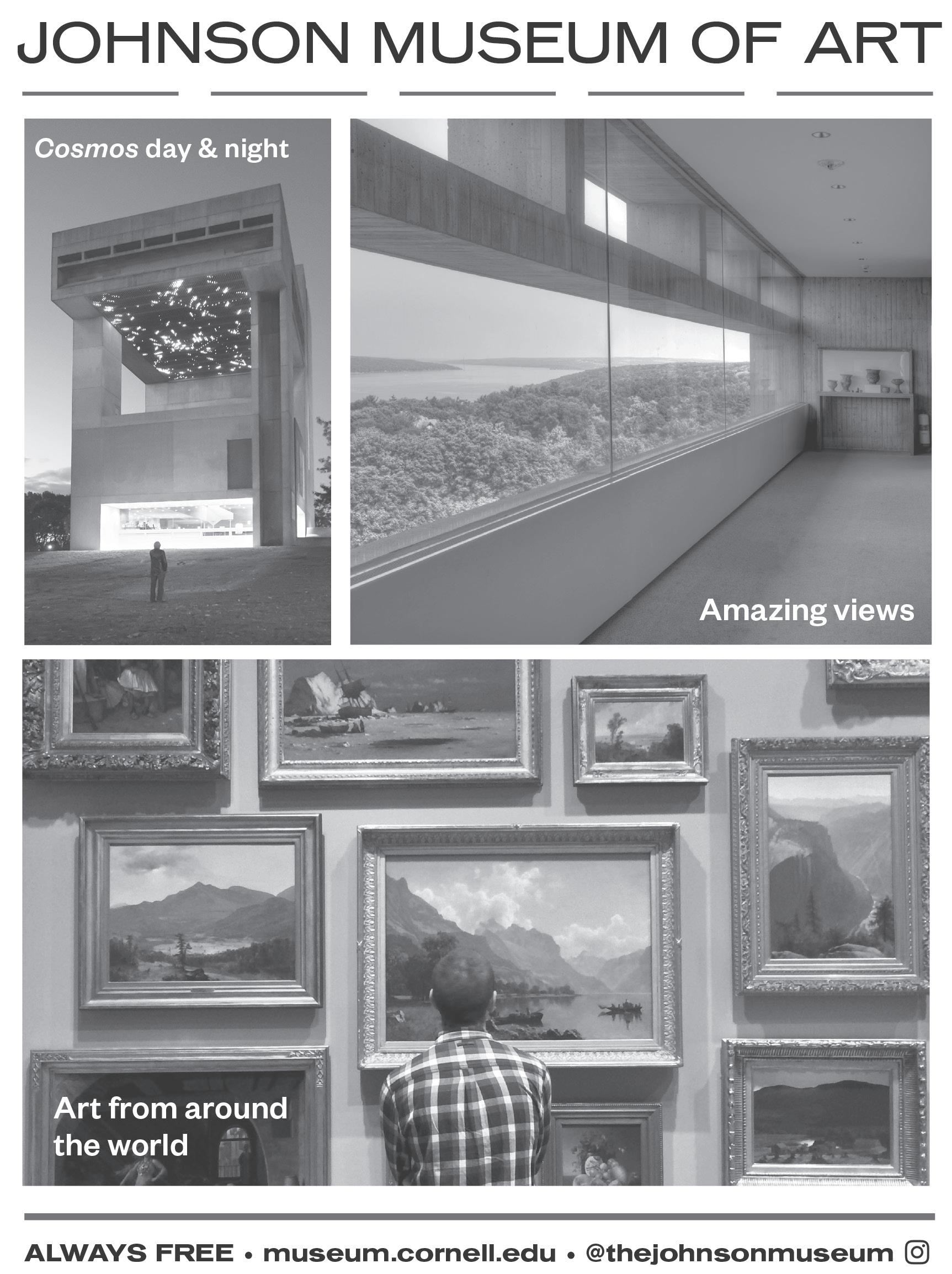
No. 1 Men’s Lacrosse Wins National Title
Men’s lacrosse beat No. 2 Maryland, Claiming the Title for the First Time Since 1977
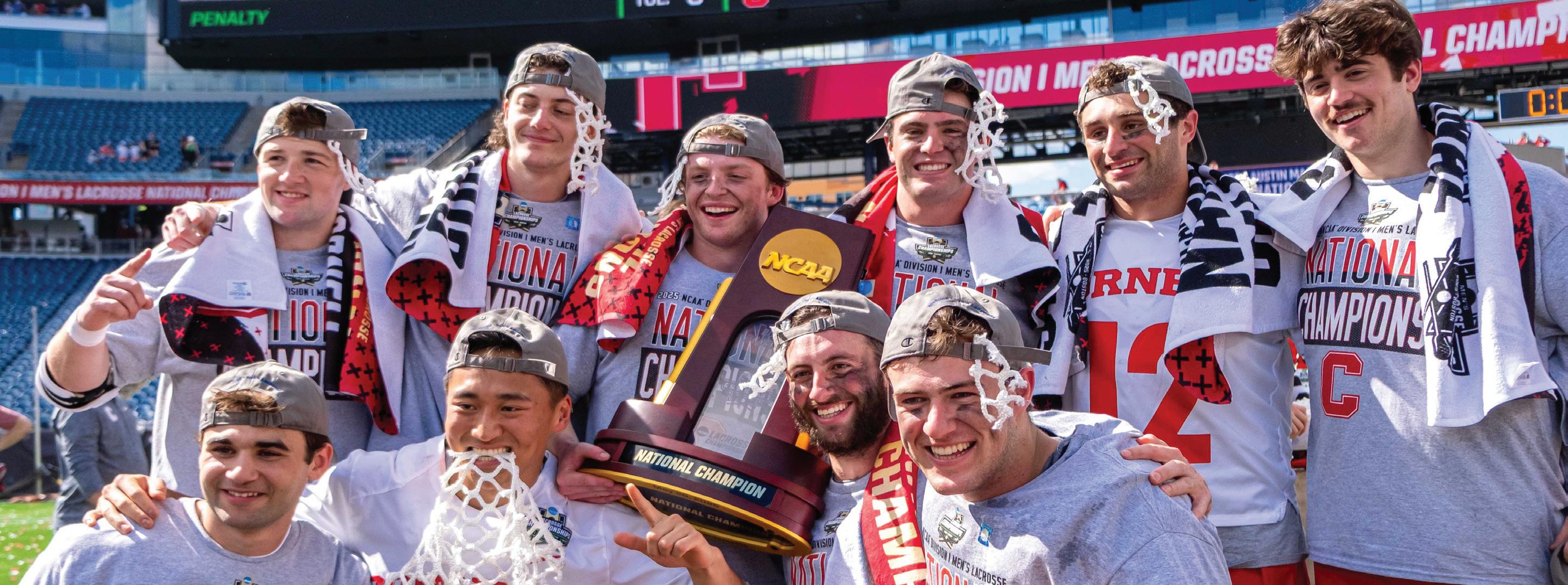
By ALEXIS ROGERS and WILLIAM D. CAWLEY
Sun Sports Editor and Sun Staff Writer
FOXBOROUGH, Mass. – The stakes had never been higher for Cornell lacrosse.
The program won the first-ever NCAA Tournament Final held in 1971. It earned the national championship title again in 1976. It sought to end a nearly 50-year NCAA Final drought in 2022, but fell three goals short of the crown.
Every one of those games was against the University of Maryland.
The Red took its last national title in 1977, but Cornell hadn’t made it back to the top for almost 50 years — until now.
On Monday, the two dynasties met again in the Memorial Day clash as the top seeds in the country. The pressure built up from a rivalry as old as the NCAA Tournament itself came to a head, and after a furious back-and-forth match in front of 32,512 spectators, No. 1 Cornell (18-1, 6-0 Ivy) took a 13-10 victory over No. 2 Maryland (14-4, 3-2 Big 10).
“For these guys to achieve this goal, to bring the title back to Cornell for the first time in 48 years, I simply don’t have the words for it,” said head coach Connor Buczek ’15 MBA ’17. “I’m so proud as an alum, as a guy that gets to work with them every single day. They’ve earned everything that they’ve gotten.”
Senior attackman CJ Kirst made it into the record books one last time, tying the NCAA record for single-season goals after scoring six for his final farewell to the Red.
Sophomore midfielder Ryan Waldman got the first goal of the game after a frantic start, and Maryland’s Bryce Ford picked up a deflected shot and scored to bring it even.
Cornell attempted multiple attacks on the Maryland goal, but were shut down until just over a minute
remained in the first quarter. Senior attackman Michael Long assisted junior midfielder Brian Luzzi to give the Red a 2-1 advantage to end the quarter. Both of the Red’s first two goals came from the second midfield unit.
“That second midfield for us this year has been a collection of different faces. Our motto is a relentless commitment to improvement, and those guys have embodied it on the biggest stage,” Buczek said. “Those guys were a huge part of us starting up on the offensive end.”
Though the first 15 minutes were carefully paced, partially due to Maryland’s swarming defense and measured offensive tactics, the second quarter began at a quicker clip, both teams finding success within the first three minutes.
Cornell didn’t hold the lead for long, as Daniel Kelly buried a shot 10 seconds after the quarter’s starting faceoff. Sophomore attackman Ryan Goldstein answered after beating his defender late in the shot clock.
Eric Spanos beat his defender to bring the score to a 3-3, but senior midfielder Andrew Dalton struck on a low-to-high shot to put the Red back ahead. Goldstein extended the lead to two not long after with an unassisted shot.
“Coach Buczek pulled me aside for the second quarter and was like, ‘Play your game. Have some confidence.’”
CJ Kirst ’25
After another Maryland goal, Kirst powered past defenders for a bouncing solo shot, a comeback after being held scoreless against Penn State in the semifinal.
The Terrapins didn’t let Cornell rest, firing one back. Maryland almost tied it up before halftime, but a big block from Dalton kept the Red in a tight 6-5 lead going into halftime.
“With that little word of wisdom, I was able to do it. I have my teammates
to thank, because they have my back,” Kirst said.
Kirst dodged to the crease, getting separation from his defender around a screen, and scored the first goal of the second half. He repeated the feat minutes later to complete his hat trick.
Maryland fired back to cut the lead to two, but Kirst made a wraparound goal, his 80th of the season, to keep the Red up 9-6. The Terrapins responded closely after, bringing the score to 9-7, an inverse of the final result of 2022’s national championship, before the final quarter.
After the Cornell ride forced a turnover, Goldstein scored to put the Red up three. Maryland found a cutter shortly after to get one back. Maryland goalkeeper Logan McNaney robbed Kirst on a crease dive before the Terrapins got a crease dive of their own, cutting the Cornell lead to one.
“Our
defense stepped up huge. After they scored those two goals in the fourth, we knew that we needed to up our communication, play more aggressive.”
Wyatt Knust ’27
Kirst scored his fifth of the game to stop the Maryland run, and Goldstein piled on to bring the Cornell lead back to three. With a 12-9 lead and four minutes remaining, the Red could taste the national championship, but couldn’t let up — a threegoal advantage with two minutes left wasn’t enough to prevent its only loss of the year to Penn State on March 8.
Maryland got one back with just under 90 seconds remaining, and Cornell won the ensuing faceoff to retain possession and took its last timeout, with Buczek sprinting onto the field to get the call. The Terrapins pulled their goalkeeper, leaving an empty net for Kirst to attack for his sixth goal of the game, bringing him to 82 on the season — tying the NCAA record for single-season goals.
“After they scored those two goals in the fourth, we knew that we needed
to up our communication, play more aggressive,” said senior goalkeeper Wyatt Knust. We really brought it for those final possessions.”
The time ran out with Cornell ahead 13-10, leaving Gillette Stadium in possession of its fourth championship trophy of all time. After four straight losses in the NCAA Final, including heartbreak in 2009 and 2022, this long-awaited trophy will be the first to come to Ithaca since 1977.
After being erased on Saturday, Kirst stormed back with six goals and one assist to lead the Cornell offense and earned the Most Outstanding Player distinction for the tournament. Goldstein also had a fantastic performance, scoring four goals.
“Having the opportunity to play with Ryan [Goldstein] for two years has been incredible,” Kirst said. “He’s just a fearless competitor. He brings everything he has every single day. The future is bright, and I know he’s going to be Player of the Year. He’s going to have it all.”
Though the Red only won 44 percent of faceoffs, it picked up a valuable 30 ground balls.
Knust outdueled his counterpart in McNaney, posting a 55 percent save percentage in his final game for the Red. Each individual contribution added up to a historic Cornell team which catapulted into the 2025 season from the start.
“[Cornell was], over the course of the year, the best team. They just were,” said Maryland head coach John Tillman ’91 after the game. “They reminded me of our ’22 team in a lot of ways.”
The Red now parts with 15 graduating seniors, including Kirst, Knust, Kelleher and Long, key components of the starting lineup. However, as Kirst says, the future is bright for Cornell lacrosse, as it now has a national title under its belt for the returning players to remember.
“No one ever had any doubt,” Knust said. “Everyone believed the entire way, and that focus got us to where we needed to be.”
Kings of the NCAA | No.1 men’s lacrosse defeated No.2 Maryland 13–10 to win its first NCAA lacrosse title since 1977, led by CJ Kirst’s record-tying six goals.
TIMMY XI / SUN STAFF PHOTOGRAPHER
